Peak Design has expanded its tripod lineup by launching three new Pro Tripod models, developed in collaboration with adventure photographer and filmmaker Jimmy Chin. The Pro Lite, Pro, and Pro Tall models build on the highly packable, non-circular leg design first seen in the popular Travel Tripod by offering more robust designs that can support heavier, professional-grade cameras and videography equipment. The Pro Tripod range was successfully funded on Kickstarter, raising more than $4.5 million.
In this review, we will take a deep dive into my hands-on experience with the entire Pro Tripod range. We will compare all three models, test and review all of the included and optional accessories such as the Tilt Mod and Pro Leveling Base, and take a detailed look at how the Pro Tripods compare to the Travel Tripod lineup. Common discussion topics, such as using third-party ball heads with the Pro Tripods, and stability differences between the various models, will also be covered. I didn’t love everything, so we’ll need to discuss a few major issues and concerns.
Disclaimer: Peak Design temporarily loaned me pre-production versions of all three Pro Tripod models for this review. No money changed hands, and Peak Design was not permitted to review the content before its publication.
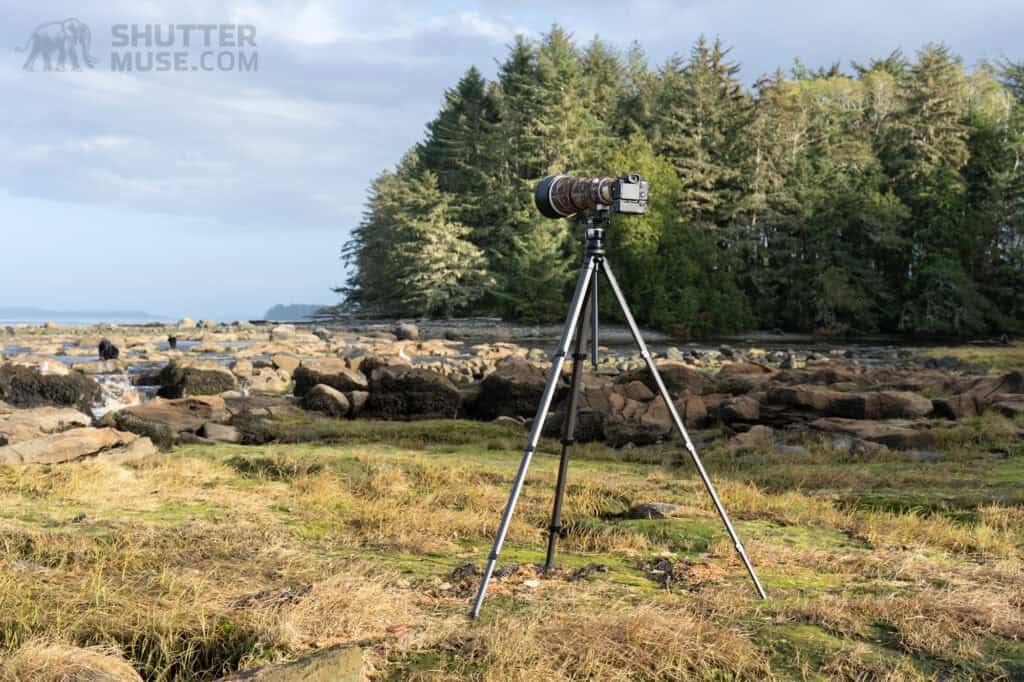

Disclaimer: Peak Design temporarily loaned me all three Pro Tripod models for this review, before they were available to the public. No money changed hands, and Peak Design was not permitted to review the content before its publication.
Why trust me? The internet is full of garbage written by AI and people who pretend to use the photo gear they are testing. On the other hand, I get out there and do the work, as evidenced by the images I create along the way and the stories I share with my followers. If you want to support an independent creator, please consider sharing this article, subscribing to my newsletter, leaving a tip, or purchasing through links on this page.
Don’t have your Pro Tripod yet? Support my efforts by buying it through one of the links below:
- PD Pro Lite Tripod – Peak Design / B&H / Adorama / WEX (UK)
- PD Pro Tripod – Peak Design / B&H / Adorama / WEX (UK)
- PD Pro Tall Tripod – Peak Design / B&H / Adorama / WEX (UK)
- PD Pro Leveling Base – Peak Design / B&H / Adorama / WEX (UK)
- PD Tilt Mod – Peak Design / B&H / Adorama / WEX (UK)
- PD Pro Tripod Spikes – Peak Design / B&H / Adorama / WEX (UK)
- PD Pro Lite Tripod Spikes – Peak Design / B&H / Adorama / WEX (UK)



Table of Contents
Peak Design Pro Tripod Specifications
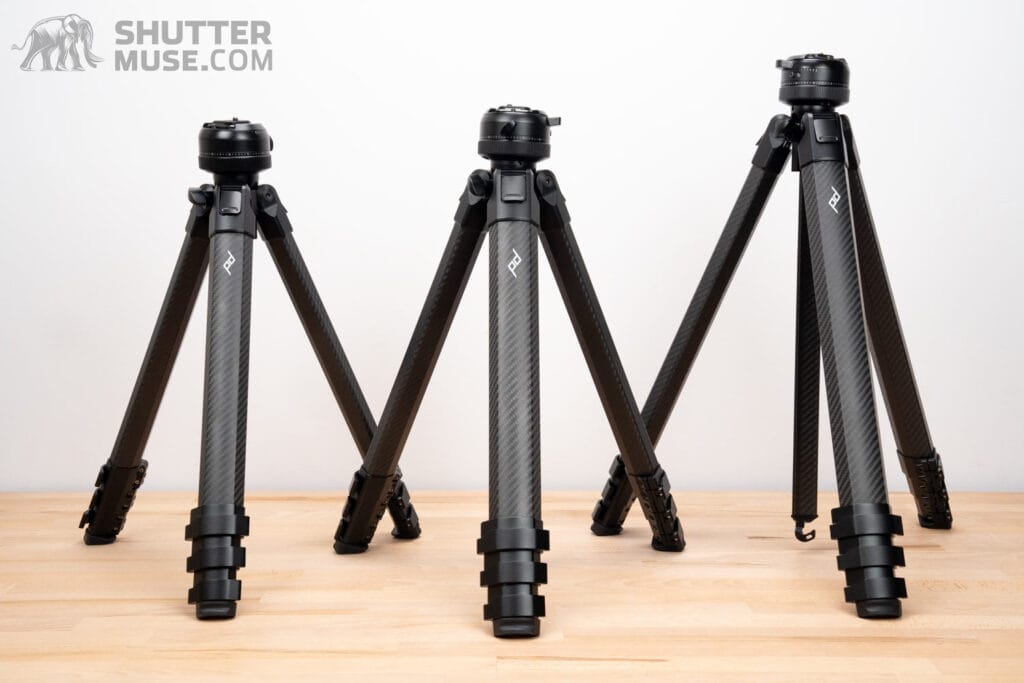
| Pro Lite | Pro | Pro Tall | |
|---|---|---|---|
| Collapsed Length | 19.2″ (48.8 cm) | 19.7″ (50.1 cm) | 22.9″ (58.1 cm) |
| Collapsed Diameter | 3.35″ (8.5 cm) | 3.66″ (9.3 cm) | 3.66″ (9.3 cm) |
| Max height (center column raised) | 64″ (162.5 cm) | 66.3″ (168.4 cm) | 77″ (197.4 cm) |
| Max height (center column down) | 52.5″ (133.2 cm) | 54.3″ (138 cm) | 63.8″ (17.3 cm) |
| Min height (low mode): 14 cm (5.5”) | 6.2″ (15.8 cm) | 6.3″ (15.9 cm) | 6.9″ (17.3 cm) |
| Leg Profile Size | 41.7mm | 47.4mm | 47.4mm |
| Weight Capacity | 35 lb (15.9 kg) | 40.1 lb (18.1 kg) | 40.1 lb (18.1 kg) |
| MSRP | $799.95 | $899.95 | $999.95 |
Peak Design Pro Tripod and Component Weights
Peak Design provides the weight for the Pro Tripod’s standard configurations, including the Pro Ball Head. Since many people are very particular about tripod weight, and because these tripods are highly customizable with various accessories or center column removal, I took the time to weigh all components individually.
| Item | Weight (g) | Weight (oz) |
|---|---|---|
| Pro Lite Tripod – Standard Config [Includes centre column, Pro Ball Head, phone holder, hook] | 1,705 | 60.1 |
| Pro Tripod – Standard Config [Includes centre column, Pro Ball Head, phone holder, hook] | 1,930 | 68.1 |
| Pro Tall Tripod – Standard Config [Includes centre column, Pro Ball Head, phone holder, hook] | 2,063 | 72.8 |
| Pro Lite Tripod – Pro Ball Head switched for Pro Leveling Base | 1,669 | 58.9 |
| Pro Tripod – Pro Ball Head switched for Pro Leveling Base | 1,894 | 66.8 |
| Pro Tall Tripod – Pro Ball Head switched for Pro Leveling Base | 2,027 | 71.5 |
| Component Weights Listed Below | ||
| Pro Lite Center Column | 62 | 2.2 |
| Pro Center Column | 64 | 2.3 |
| Pro Tall Center Column | 77 | 2.7 |
| Pro Lite Legs | 1,228 | 43.3 |
| Pro Legs | 1,454 | 51.3 |
| Pro Tall Legs | 1,572 | 55.5 |
| Pro Ball Head | 386 | 13.6 |
| Pro Leveling Base (optional) | 350 | 12.4 |
| Tilt Mod (optional) | 431 | 15.2 |
| Pro Lite Case | 197 | 7.0 |
| Pro Case | 210 | 7.4 |
| Pro Tall Case | 228 | 8.0 |
| Tripod Hook | 11 | 0.4 |
| Tripod Plate | 17 | 0.6 |
| Tripod Tool | 19 | 0.7 |
| 3x Spiked Feet (optional) | 120 | 4.2 |
Pro Tripod Design and Features
Pro Ball Head

The Pro Tripods come with an integrated ball head, which Peak Design calls the Pro Ball Head. The head is an inverted ball head, placing the pivot point —the ball —below the panning base and the clamp. This inverted design means the head can be used as a leveling platform, which is useful for panoramic photography.


Considering the head’s relatively small size, Peak Design has packed a remarkable amount of functionality into it. Starting at the bottom, there’s a large knurled metal ring that loosens the ball and allows you to level the camera. If you are aiming to level the camera perfectly, a bubble level is integrated into the top clamp. The head also features a 45-degree drop notch to flip your camera into portrait orientation. With the center column fully collapsed, the head has a 15-degree range of motion. If you want the full range, you’ll need to loosen the center column locking knob and raise the camera an inch or two.
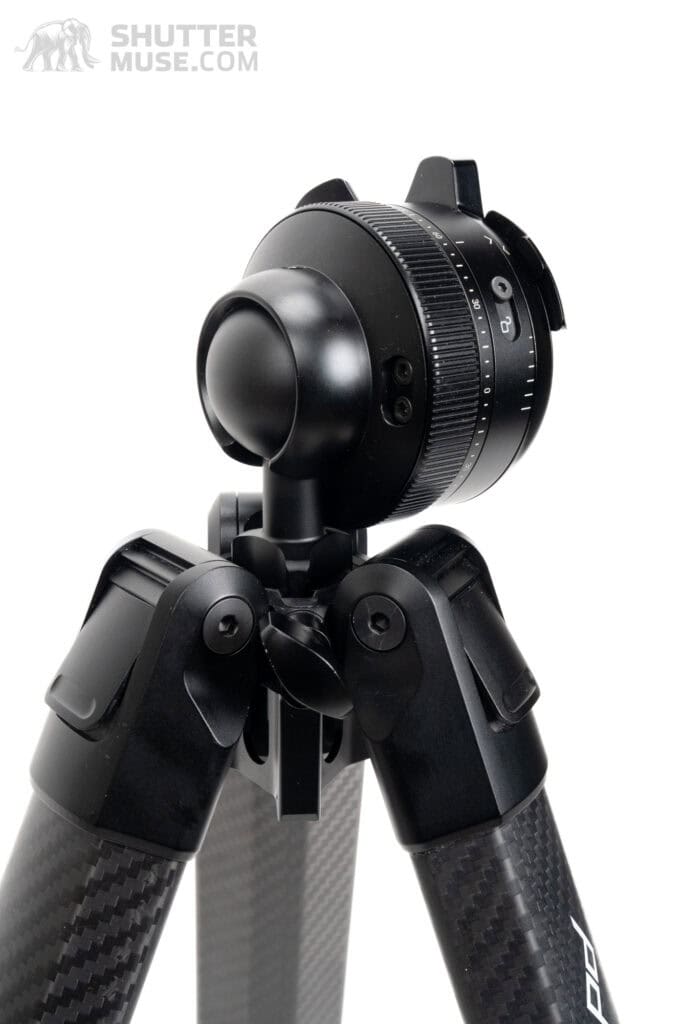
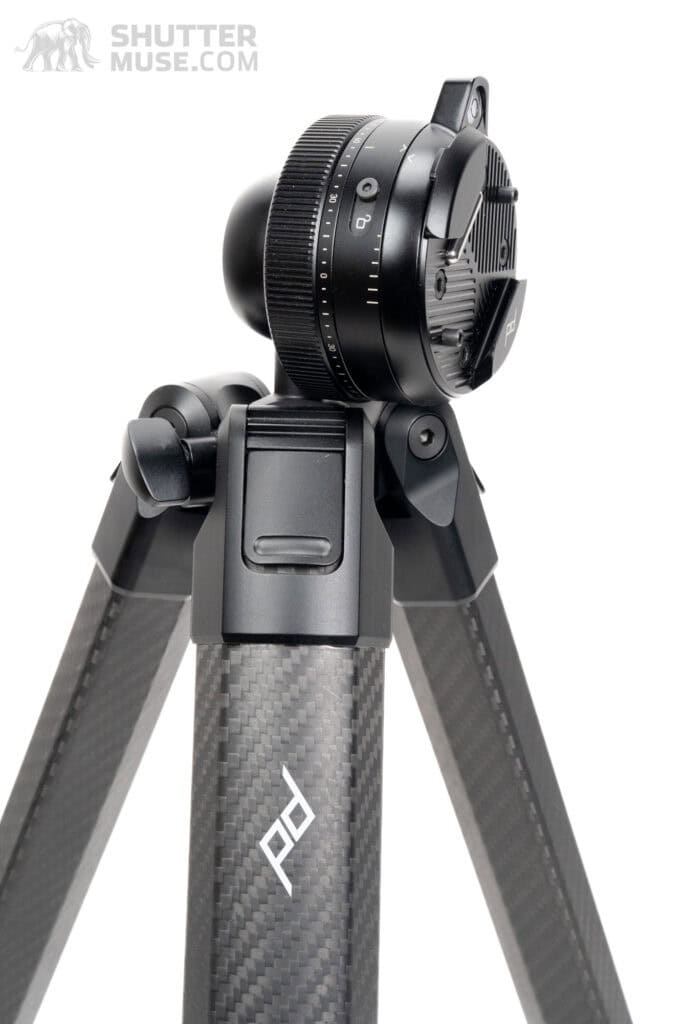
Sitting above the main ball locking ring is the fluid panning platform. It’s rare for a ball head to include a feature like this, and I was incredibly impressed by the smoothness of the panning motion. While still photographers do not often need smooth panning, this feature comes into play when the tripod is paired with the Tilt Mod option for filmmakers, discussed later in the review. A laser-etched 360-degree scale is included on the panning platform for panoramic photographers, and a metal knob extends from the side to tighten and loosen the panning platform.
Next, we have the tripod clamp on top of the ball head. The clamp is Arca-compatible, meaning you can use it with the included Peak Design quick-release plate or a third-party Arca plate. To open the jaws of the clamp, push your thumb against the large metal protrusion that houses the bubble level. When fully opened, the clamp jaws lock in place. Pushing a camera with an attached plate into the jaws depresses the silver-colored, pill-shaped button, which closes the spring-loaded clamp jaws. The clamp can be further tightened by pushing on the bubble level protrusion, and a lock switch can be engaged to prevent the clamp from opening accidentally.

Overall, I think Peak Design has done a great job with the Pro Ball Head. It feels premium and has no trouble supporting heavy camera gear. That said, there is one thing that bothers me: In the photo of the Pro Ball Head’s clamp, you’ll notice a pair of removable safety-stop screws. These are designed for use with the included Peak Design standard camera plate, and you’ll want to remove them if you are using a third-party Arca plate. Nothing wrong with that. However, the clamp lacks the standard safety-stop cut-outs found on all other Arca-compatible clamps in the industry.
These cut-out channels allow you to use safety-stop screws on the bottom of your Arca-compatible quick-release lens or camera plate. If you like to use safety-stop screws as a failsafe, you’ll need to ensure the screws are spaced at least 70mm apart, which is the width of the clamp. While I don’t see many people using safety-stop screws on camera plates, I do notice a lot of them on lens feet. Considering the greater capacity of the Pro Tripods compared to the old Travel Tripod, and thus the higher likelihood of people using larger lenses with foot mounts, I find this omission unfortunate and a bit shortsighted.
Center Column

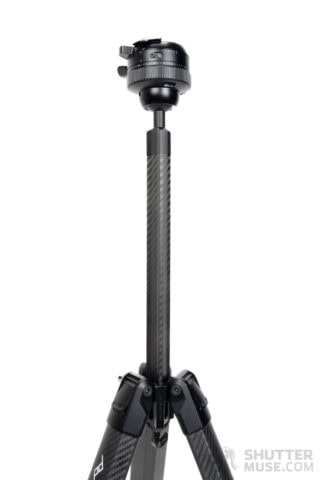
The Pro Tripod features a carbon center column with an integrated metal hook at the base for hanging a weight or your camera bag. The column is hollow, and removing the tripod hook reveals a hidden compartment for storing the tripod tool or phone mount. The carbon column features a scolloped design, allowing it to pack neatly in between the tripod’s collapsed legs.
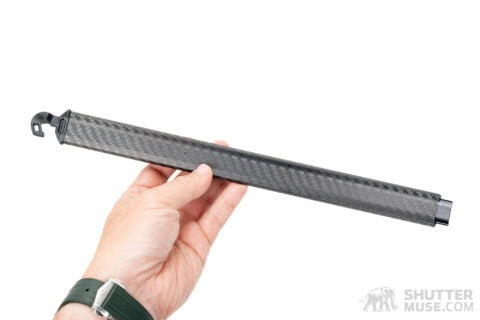

As with all center columns, a degree of instability is introduced when extended, particularly in windy conditions. A center column gives you a higher maximum height while minimizing the tripod’s packed length. It’s up to you to decide what your priorities are. Since the center column is removable, you may opt to buy the Pro Tall tripod and use it with the column removed to achieve a more stable platform at the same working height, as you would do with the Pro Lite or Pro models with extended columns.
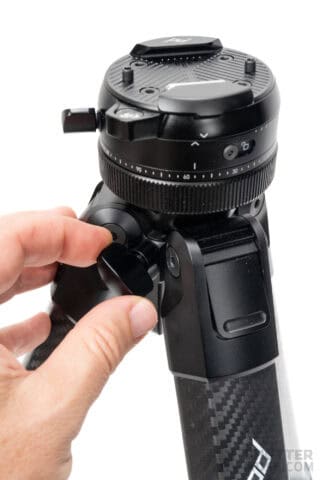
Low Mode
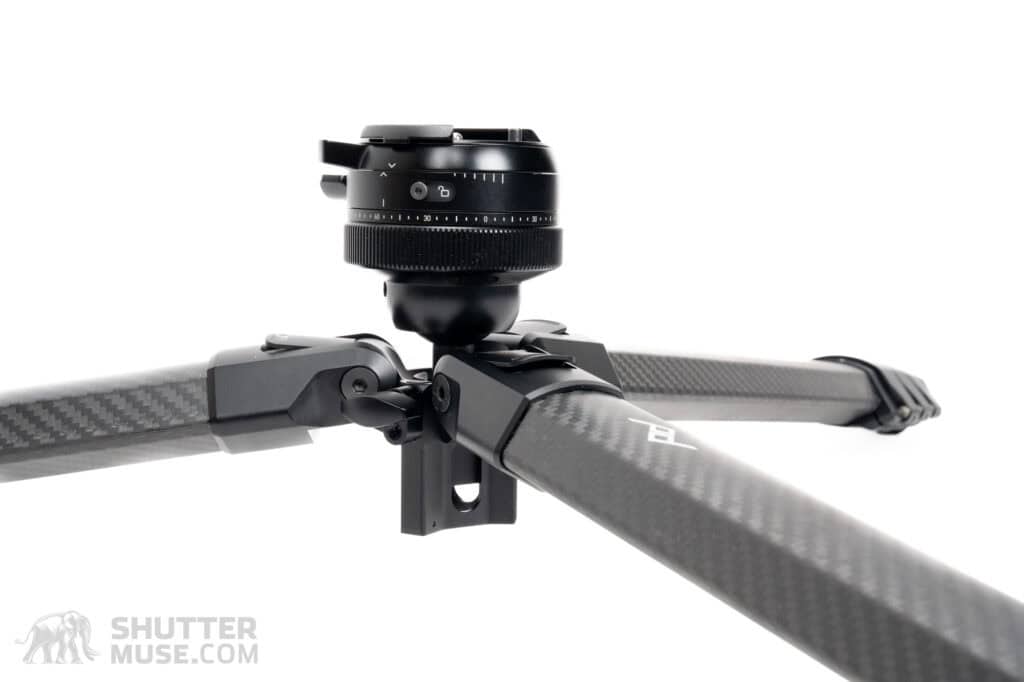
With the center column removed, the tripod can be operated in Low Mode. In this configuration, the lowest height of the Pro Ball Head’s clamp becomes: 6.2″, 6.3″, or 6.9′ for the Pro Lite, Pro, and Pro Tall, respectively. Remember what I said about the Pro Ball Head having a 15-degree limited range of motion when the center column is fully collapsed? That’s no problem because, even after removing the center column, the Pro Ball Head still has a short metal “stump” used to clamp the head to the legs. The stump measures a few inches long, allowing you to raise the head for a full range of movement on the ball.

Leg Locks

All three sizes of Pro Tripod feature four leg sections, hence three leg locks. The locks feature large metal levers that smoothly apply pressure with very minimal effort. If you are extending all three legs simultaneously, it’s easy to grab and open all three leg lock levers at the same time. Some will say this is an advantage over typical cylindrical leg locks on other tripods, but I have no issue opening multiple of them at once, either. I don’t see this leg lock design as a particular benefit. However, neither is it a negative, and Peak Design has definitely done a good job with the mechanism to provide the smooth feel and sturdy locking of a very premium tripod.
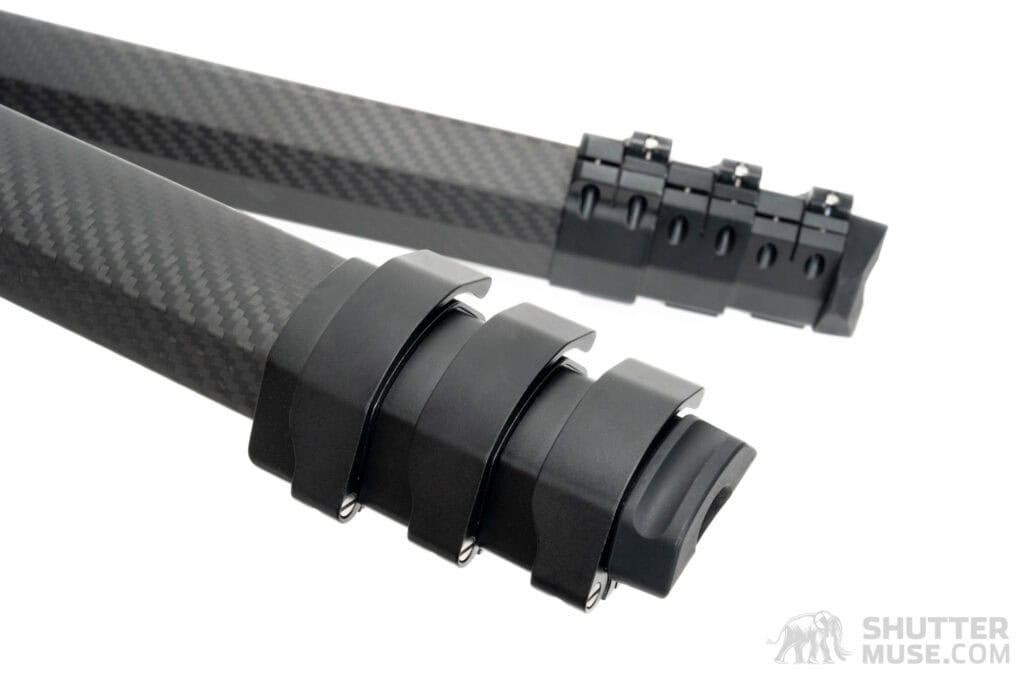
Tripod Feet
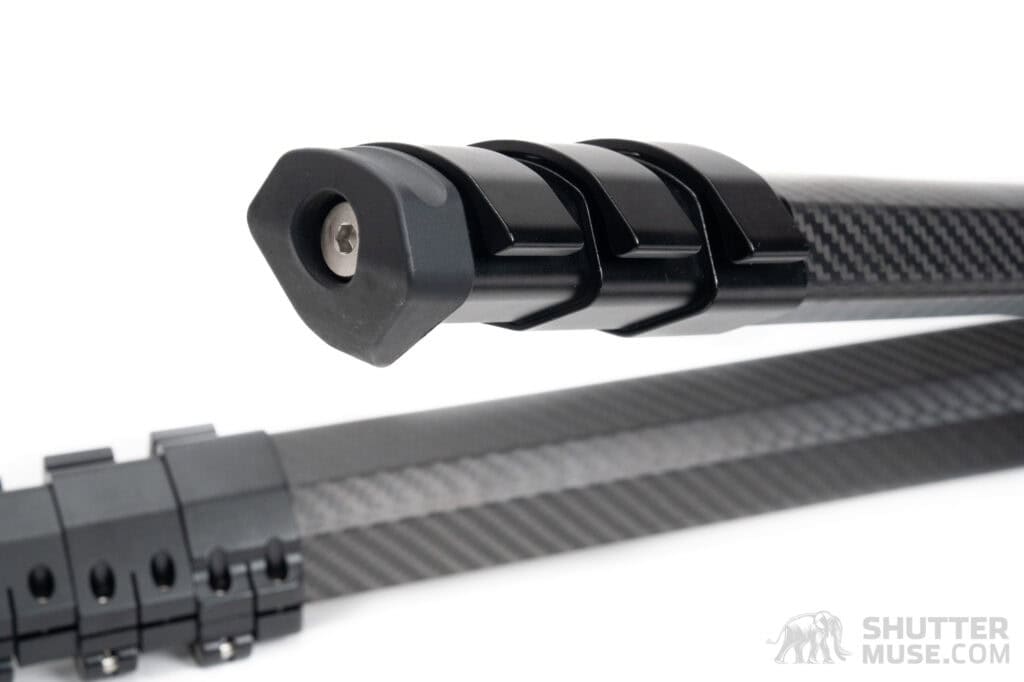
Rubber feet extend from the bottom of the tripod legs. The feet are angular, in keeping with the shape of the legs’ cross-section. Their shape and width place a little more rubber in contact with the ground than a typical hemispherical rubber tripod foot, and I found them to grip well on flat or rocky ground. One downside to their design is the recessed hex screw that attaches them to the legs. This recessed cavity can collect mud and sand, which eventually dries out and ends up in your car or the tripod bag.
Which Pro Tripod Model Is Right for You?
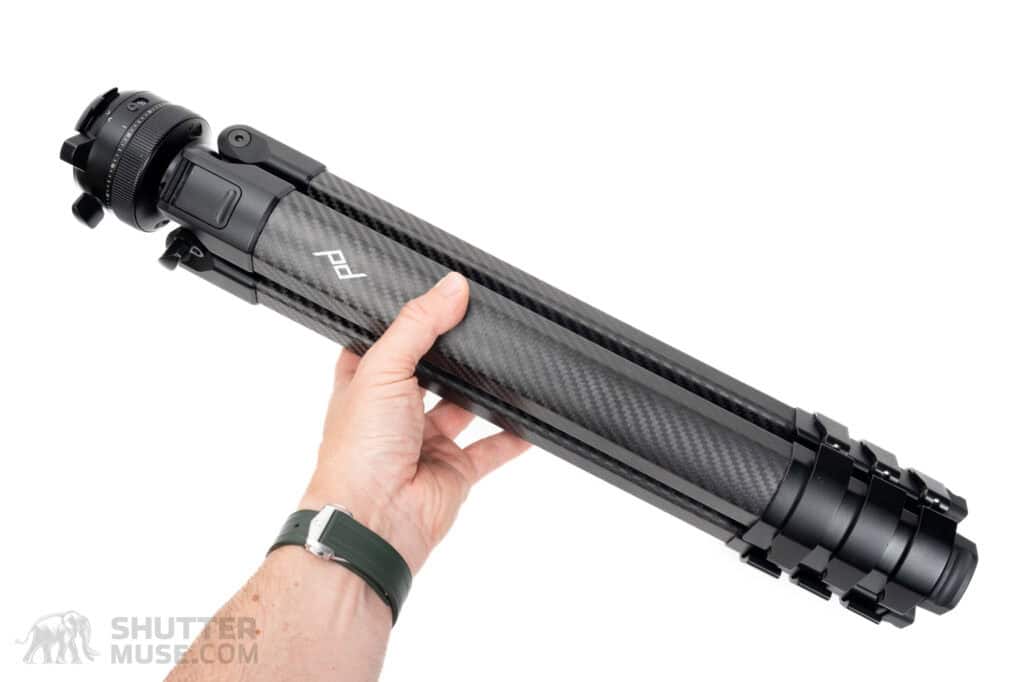
I must applaud Peak Design for offering three distinct tripod options. It would have been easy to give us the Pro Tripod and call it a day. Still, they saw the value, as I do, in designing the slightly lighter Pro Lite and the slightly taller and more stable Pro Tall. Now that we’ve taken a closer look at the overall features, I think a summary of my thoughts on tripod choice is worthwhile.
Pro Lite Tripod – Weight savings and more portability, at the expense of some stiffness. Still considerably more stable than the Travel Tripod. Much easier to pack into a carry-on bag than the Pro or Pro Tall models. An excellent choice for those who travel a lot and tend to walk all day or hike to remote locations.
I didn’t find the reduced packed size to be a notable difference from the middle-ground Pro Tripod. The decreased diameter just wasn’t obvious when strapped to a bag or packed in a duffel. The reduced weight is noticeable when packing light.
Pro Tripod – The Goldilocks tripod. If your answer to the questions “What do you like to photograph?” and “What kind of gear do you shoot with?” is usually “A bit of everything” and “All kinds of stuff”, then the Pro Tripod is the right choice for you. It offers an outstanding balance between stability, weight, portability, and working height.
There aren’t significant weight savings between this model and the Pro Tall, but the collapsed length difference is noticeable while packing the tripod for air travel in Pelican cases and duffel bags.
Pro Tall Tripod – A little heavier and longer, but slightly more stable than the other two options. Given its taller deployed height, it’s possible to remove the stability-decreasing center column and still reach an acceptable shooting height, which is my preference. Choose the Pro Tall if you are a taller photographer, or if you want to regularly use the tripod with super-telephoto lenses (400mm f/2.8, 600mm f/4, etc.), or if you value absolutely critical sharpness with high-resolution medium-format cameras.
The added torsional stiffness can also be beneficial to filmmakers who frequently pan while capturing their subjects. This is my favorite model of the three. However, my predilection for shooting with super-telephoto lenses should be noted. I’d likely opt for the middle-ground Pro Tripod if I were more focussed on landscapes.
Peak Design Pro Tripod Included Accessories
Arca Tripod Plate
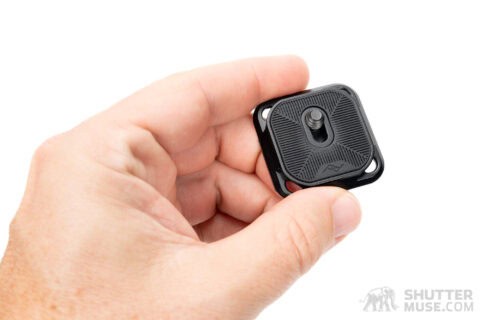

The Pro Tripods come with Peak Design’s standard Arca-compatible quick-release plate. The plate attaches to your camera using a 1/4″-20 hex screw. The included tripod tool has the correct hex key for the job. If you don’t want to bother with a hex key in the field, you could buy Peak Design’s Field Plate, a toolless version of the same plate that uses a flip-up thumb screw.
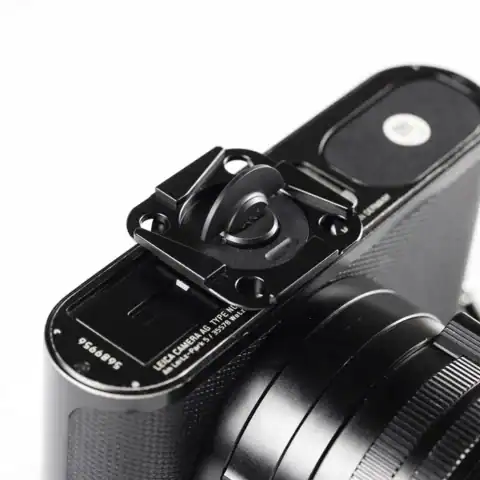
Tripod Tool
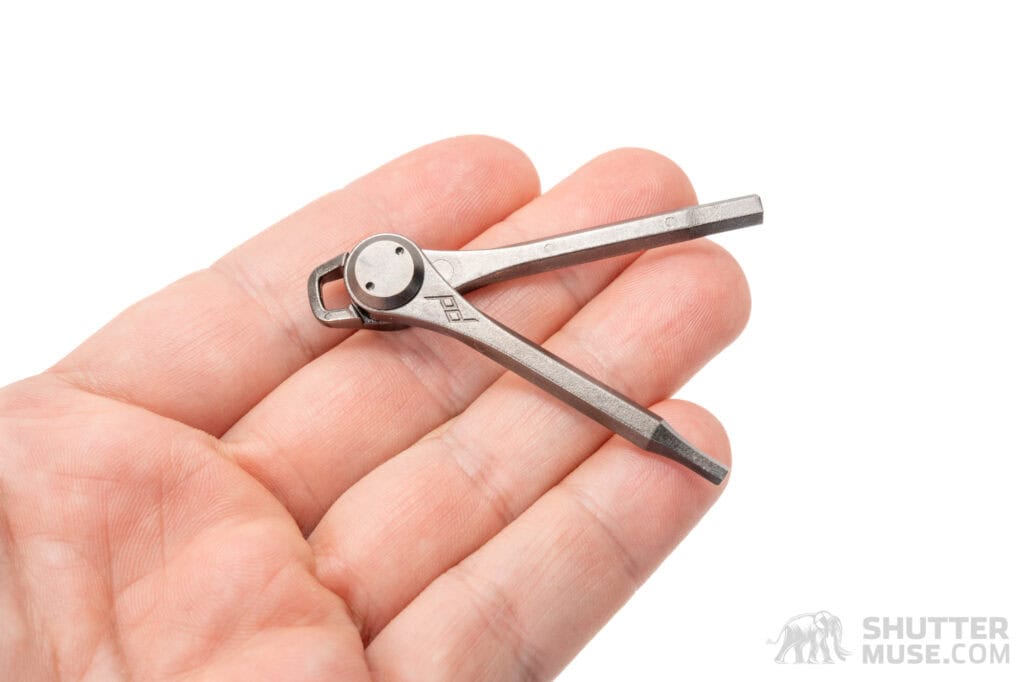
A small but useful tripod hex tool is included with every tripod and can be stored in a small pocket on the inside of the tripod cases. The tool features 2.5mm and 4mm hex wrenches, with the larger size being used for the tripod feet, Arca plate installation, Pro Ball Head removal, and the leg locks. The smaller 2.5mm wrench is used to remove the safety stop pins on the Pro Ball Head.
I really like this tool; it’s identical to the one that comes with the Travel Tripod, and it has been my go-to tool for Arca plate installation and removal for years, whether I have a Peak Design tripod with me or not. The design provides great leverage in a sturdy, compact form.
UPDATE: It appears that the tool included with my loaner test tripods is not the same tool that will be supplied with the final retail version of the Pro Tripod. Instead of getting an identical tool to the one shipped with the travel tripod, seen in the above photo, a slightly different version will be included, designed to fit within the tripod’s center column, and apparently held in place with a magnet so that it doesn’t just drop out when you remove the centre column’s hook. This means you can either choose to carry the tool or the phone mount within the center column. I suspect most will opt to carry the tool, while placing the phone mount in the pocket inside the tripod case.
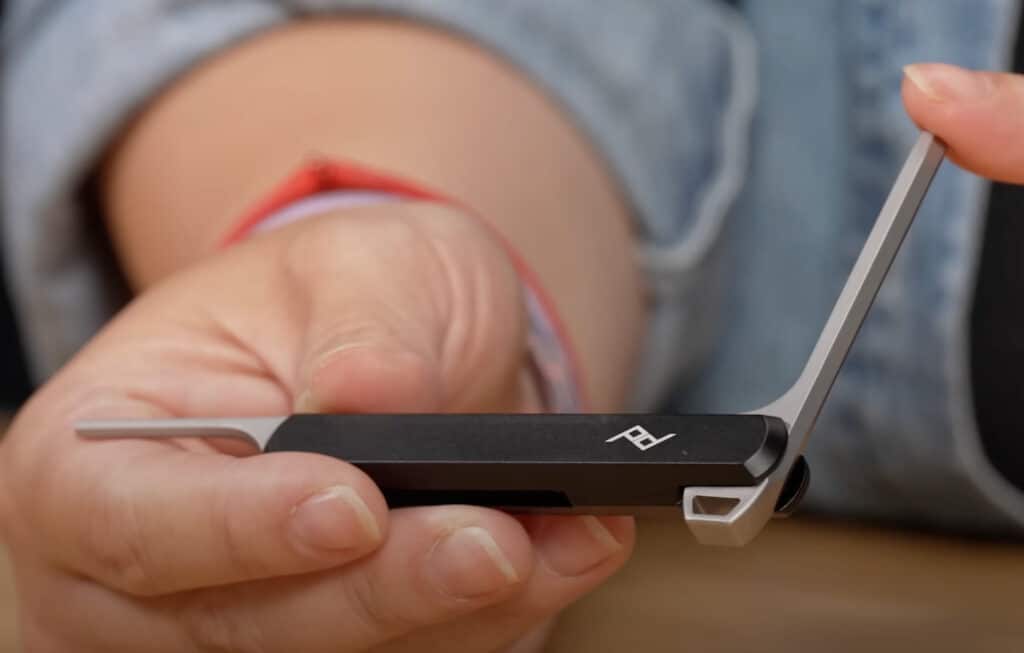
Phone Mount

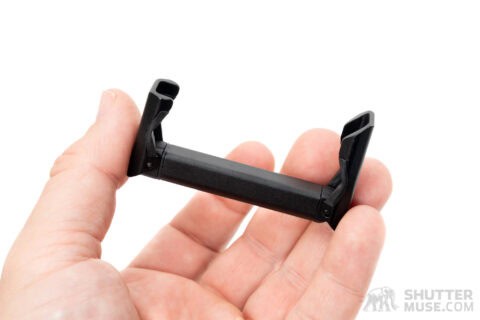
The Pro Tripod comes with a plastic, spring-loaded phone mount that expands to clamp onto most mobile devices. I had no issues clamping it to my iPhone Pro Max. The base of the phone mount fits directly into the Arca clamp on the tripod, or any other Arca-compatible clamp. When not in use, you can store the clamp in a small pocket in the tripod case or insert it into the bottom of the tripod center column.
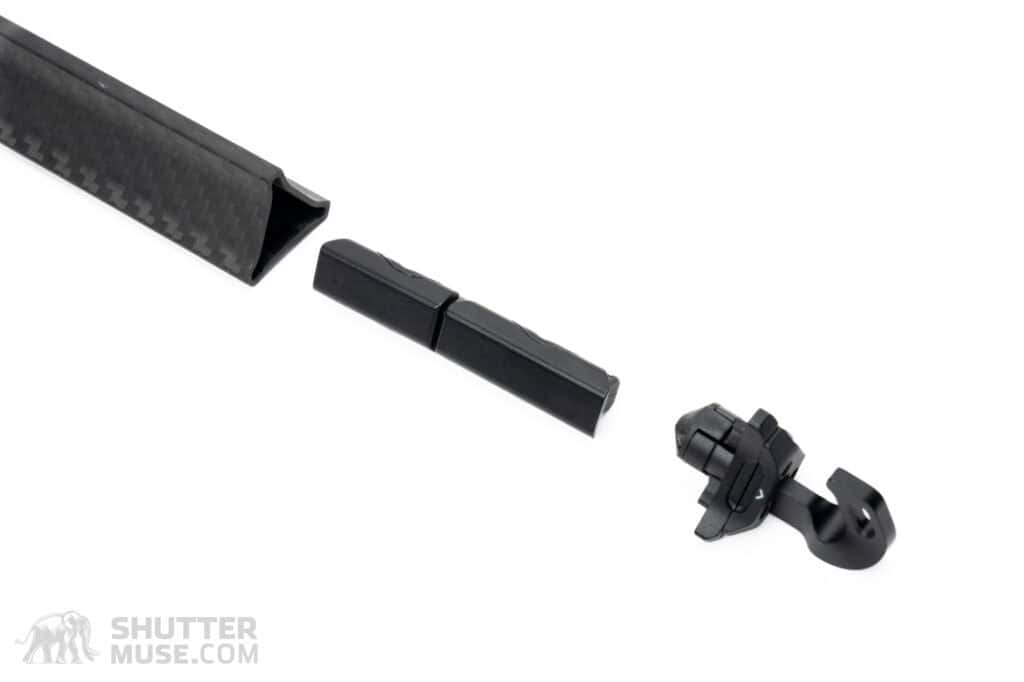
Of course, you’re not buying a Pro Tripod just to use it with your phone. However, suppose you are using an iPhone (or equivalent) for vlogging or time-lapse photography during a trip where you are already carrying the Pro Tripod for heavier gear. In that case, this may be useful.
Tripod Case
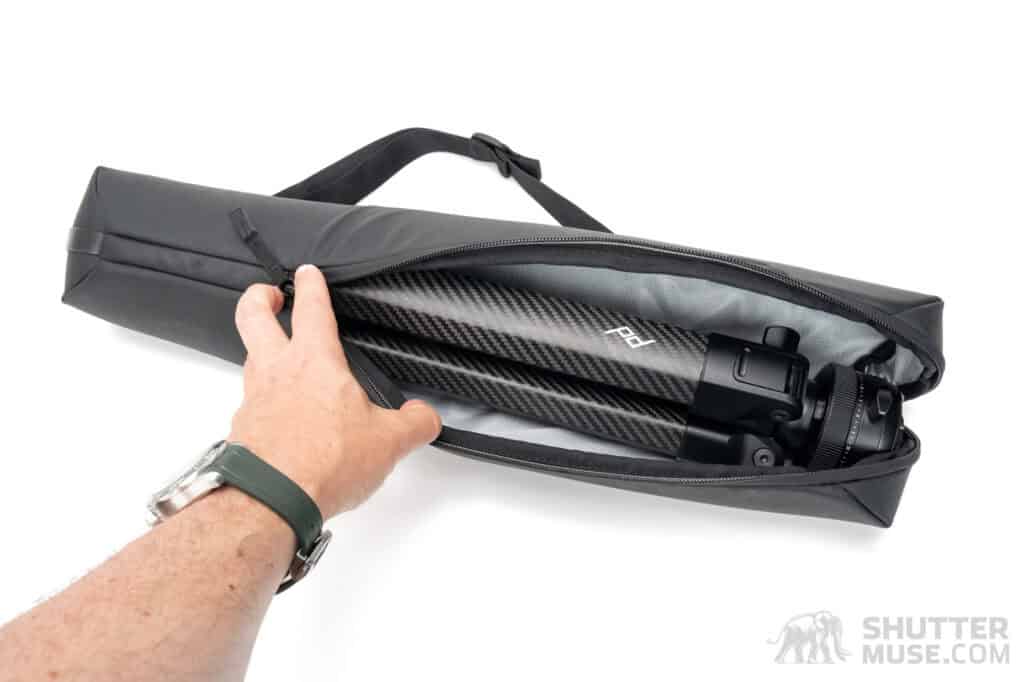
The Pro tripods come with a padded case that has a shoulder strap, grab handles, and a small pocket for storing the included tripod tool. The case is lightly padded but provides enough protection against minor bumps and scratches. The quality of the case is very good. It’s a step up from the one provided with the Travel Tripod. It doesn’t feel like an afterthought, nor does it seem like a “freebie” item. By this, I mean it doesn’t seem like Peak Design just made the cheapest option they could, simply to check an “includes tripod case” box on a feature list.

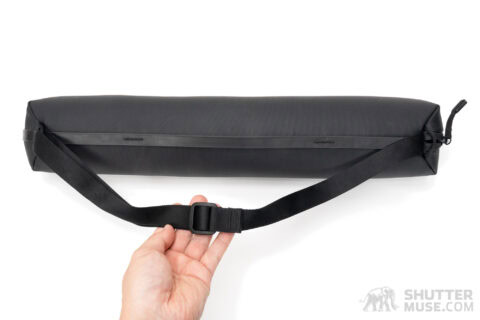
I’ve seen many essentially disposable cases included with tripods, where it’s clear that the zipper would break in just a few days, and the stitching may come loose sooner. That’s not the–no pun intended here–case with this case. Overall, this case contributes well to the experience of purchasing a premium tripod, walking the perfect line between being too big and bulky to be used often and being too weak and flimsy to offer any protection.
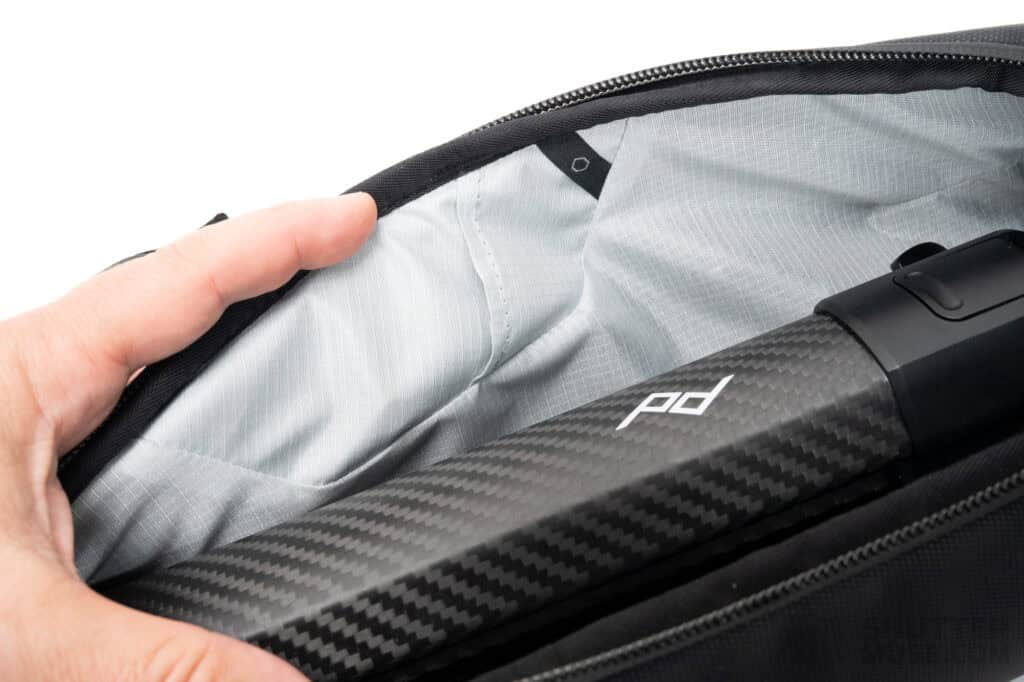
Peak Design Pro Tripod Optional Accessories
Alongside the Pro Tripod line, Peak Design introduced a range of accessories rthat enhance the compatibility and functionality of the Pro Tripods.
Tilt Mod
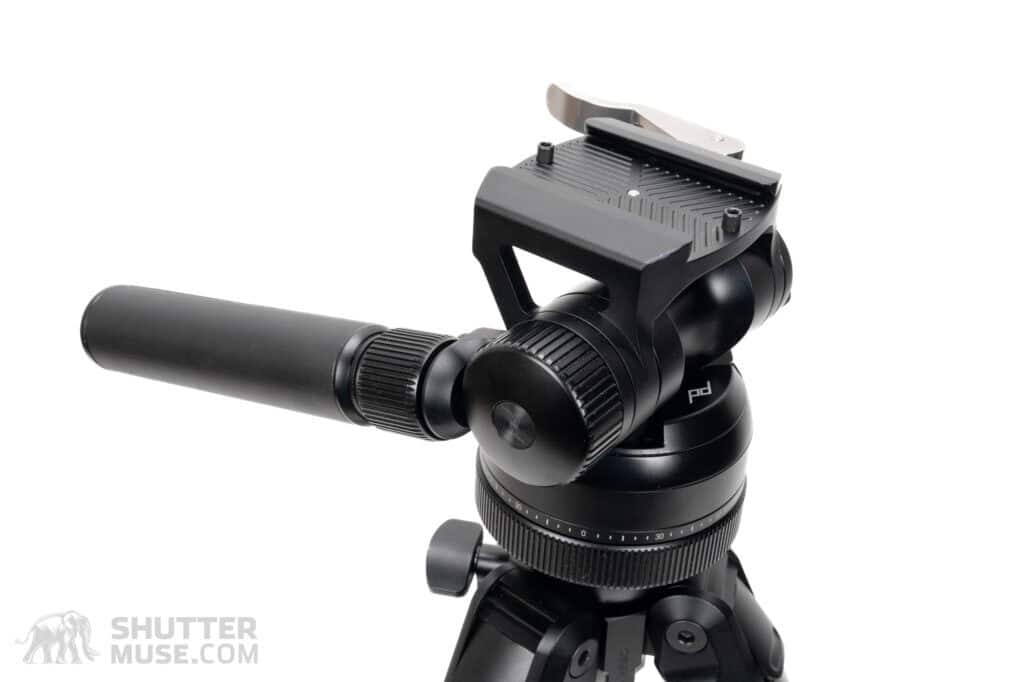
The Tilt Mod is basically a fluid tilt head with an Arca dovetail at the bottom. It is made to attach to the Pro Tripod’s included Pro Ball Head and work with the ball head’s built-in fluid panning base to create a fully functional panning and tilting fluid head for filmmaking. The Tilt Mod has a removable, telescoping handle and an Arca-compatible lever clamp.
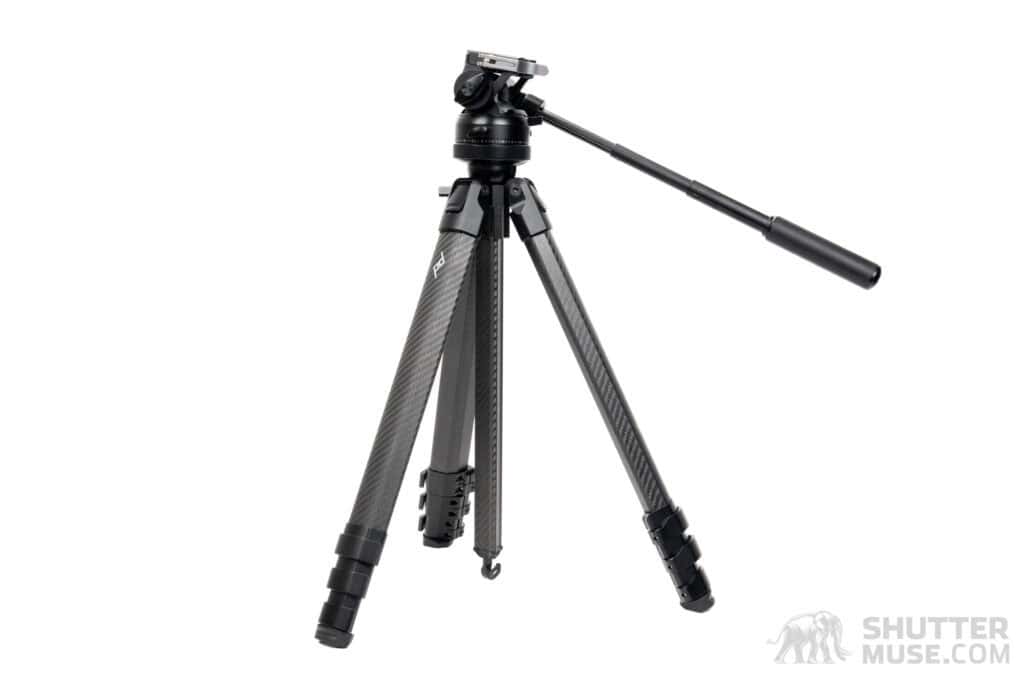
Considering how compact and affordable ($149.95) this solution is when combined with the ball head included with any of the Pro Tripod models, I was very impressed with how smoothly it operated. The outcome is much better, more compact, and lighter than purchasing a cheap, dedicated fluid head for the same price. For creators shooting stills and some video with smaller camera setups, this accessory is definitely worth considering, with one caveat.
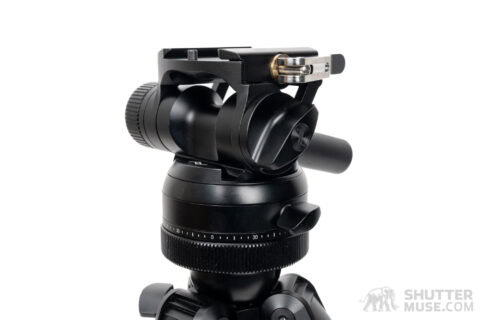

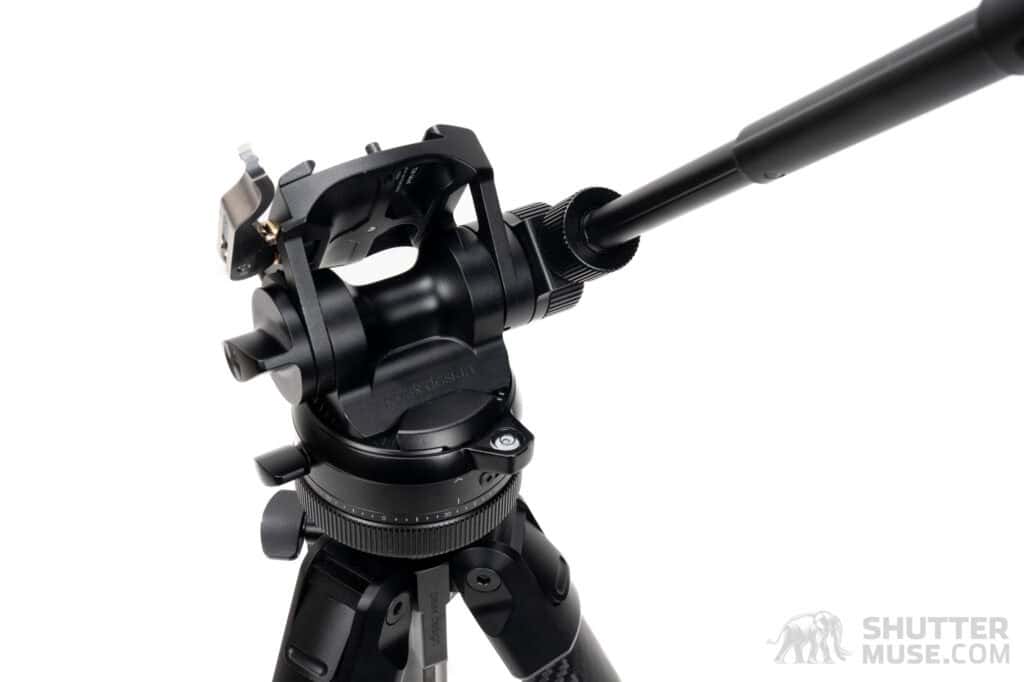
Arca Tolerance Issues
Peak Design says the lever-release clamp on the Tilt Mod is Arca-compatible. It works well with the included square-shaped Peak Design quick-release plate, but it failed to clamp several other Arca quick-release plates adequately. During my testing, I tried Arca dovetail camera and lens plates from Really Right Stuff, Kirk Photo, Wimberley, ProMediaGear, Colorado Tripod Company, 3LeggedThing, and Gitzo. Only the plates from Kirk Photo would solidly clamp in the Tilt Mod’s clamp. Some of the others would literally slide right out, and the remainder could be moved with very little force. Note: This issue was only on the optional Tilt Mod accessory – not the Pro Ball Head.
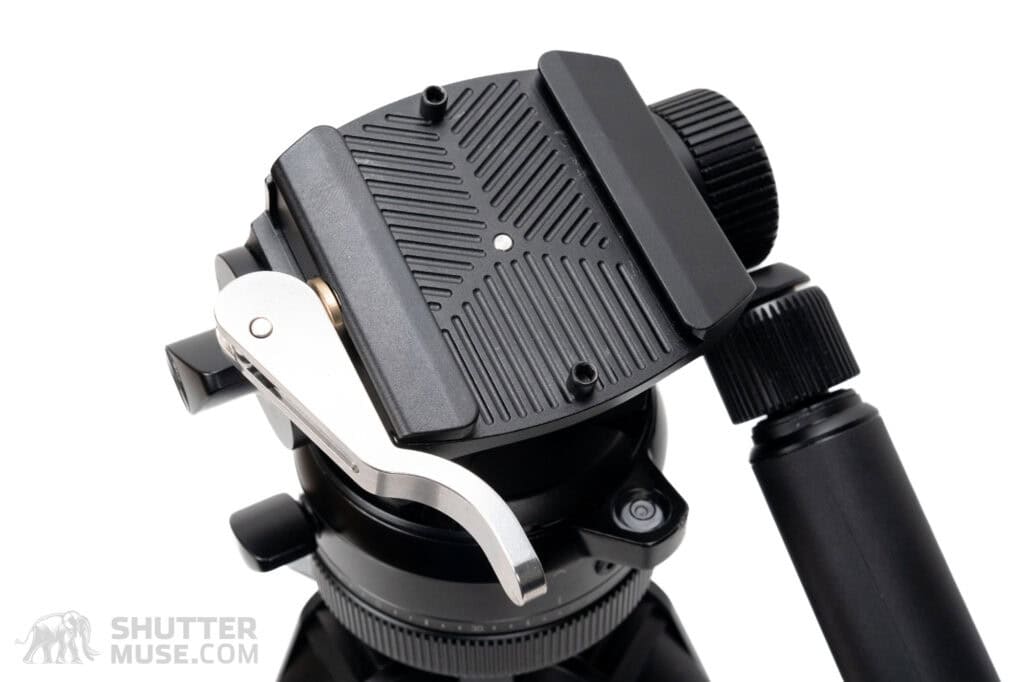
Before publishing this review, I reached out to Peak Design about my findings with the Tilt Mod and Arca plates. They informed me that this was a known issue and that it would be addressed in the final production version of the Tilt Mod. They also noted that different brands have always produced Arca plates and clamps with slightly different tolerances.
This is true. There are often slight differences in Arca plate dimensions. However, my response to them was that I have other lever clamps in my kit, from Really Right Stuff, for example, that are designed in such a way as to tightly clamp to all Arca plates. It is, therefore, entirely possible to create an Arca lever clamp that will accept a range of Arca plate tolerances. Let’s hope that is what we see on the final production model of the Tilt Mod, which will be sent to me once available. This review will be updated with my findings once I have had a chance to test it.
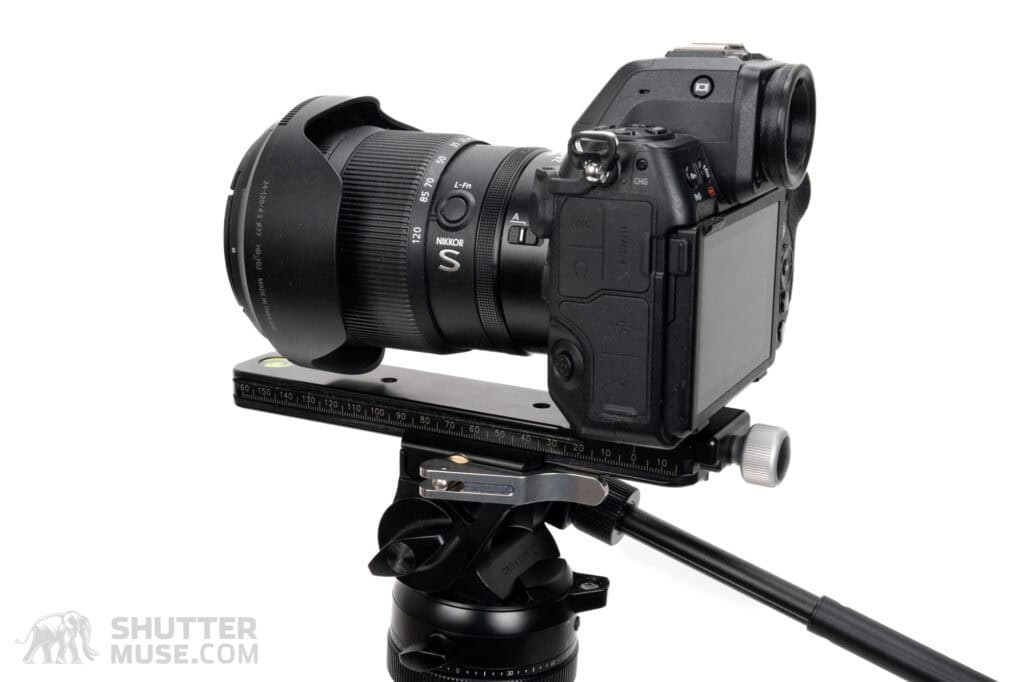
Arca Clamp Safety Stop Criticism
Further regarding the lever-release Arca clamp on the Tilt Mod, I share the same criticism as I do with the Pro Ball Head. The clamp lacks the slight recess in the top plate that would allow compatibility with many third-party safety stop screws on Arca plates. This isn’t a problem if you either don’t bother using those safety stop screws on your clamps or if the screws are farther apart than the clamp’s length, which is 2.36 inches (60mm). However, I still see this as a glaring oversight, since virtually every other Arca clamp I can find on B&H Photo – from high-end RRS to budget Sunway or SmallRig models – includes this feature.
Tilt Mod Vs Proper Fluid Head
Compared to a proper fluid video head, the Tilt Mod’s downside is the absence of a reliable variable counterbalance system, which helps stabilize heavier camera setups and prevents tilt without requiring the tilt knob to be locked. There is a counterbalance spring in the head, but honestly, I found it to be minimally useful. It’s not strong enough to balance a full-frame camera with a standard zoom lens, such as a 24-120mm or 24-70mm. The absence of variable friction on the panning axis will also lead higher-end videographers to opt for a dedicated solution.
Nonetheless, this Tilt Mod is an innovative solution for people looking for an all-in-one stills and video tripod system, and it will meet the needs of most creators who occasionally shoot video with their still cameras. It would definitely satisfy all of my needs for YouTube and social media content, and features like variable friction panning and variable counterbalance systems are never found in fluid heads at this price point, so their absence isn’t a criticism of the product, just an observation.
Pro Leveling Base
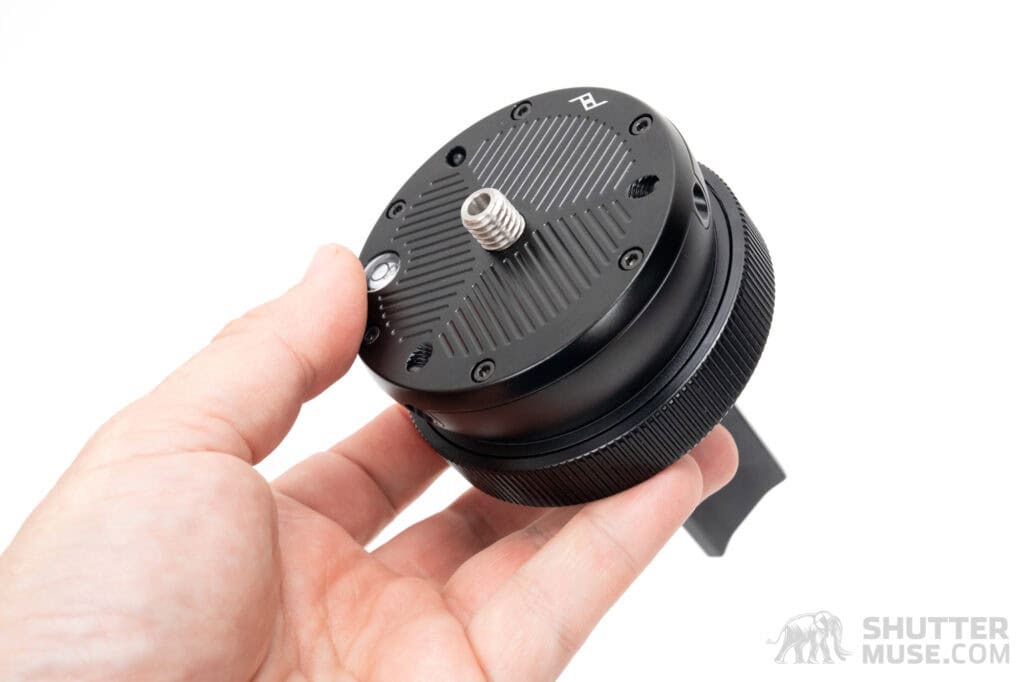
The Pro Leveling Base replaces the Pro Ball Head and has a 3/8″-16 male screw mount, letting you attach your own ball head, fluid video head, or gimbal head to any Peak Design Pro Tripod. When the locking collar is released, the Pro Leveling Base offers up to 20° of omnidirectional tilting, allowing for perfect horizontal pans when used with a fluid head or gimbal head.

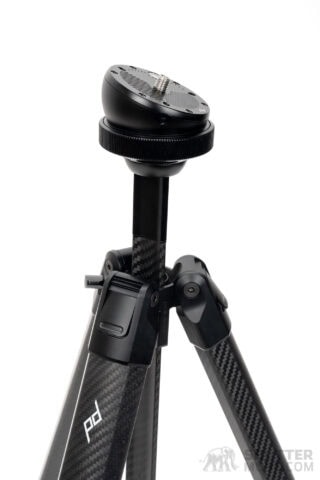

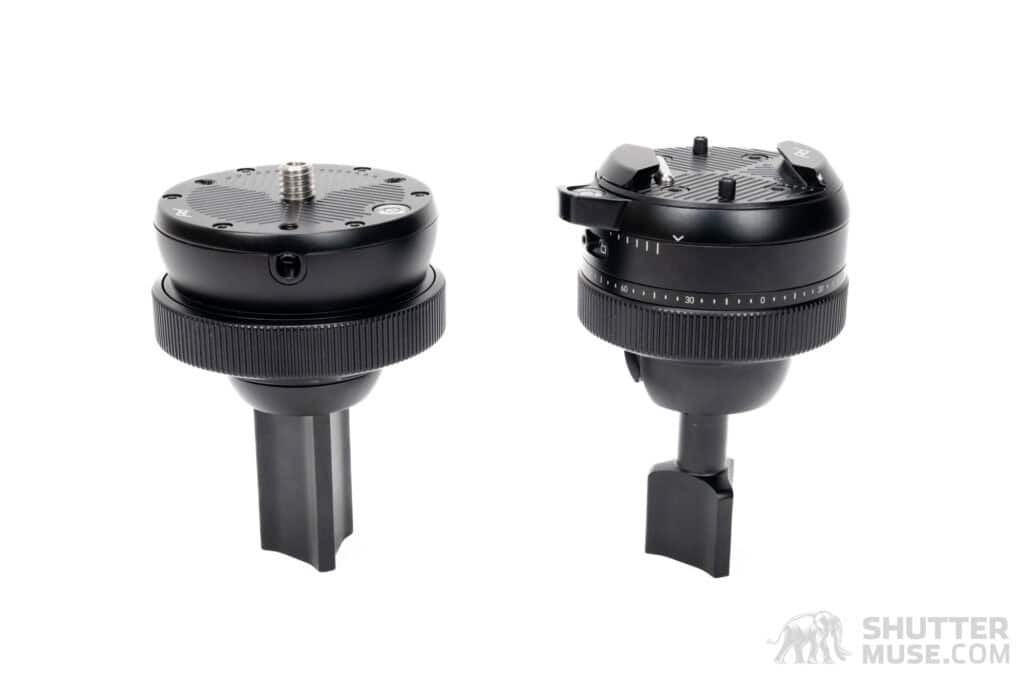
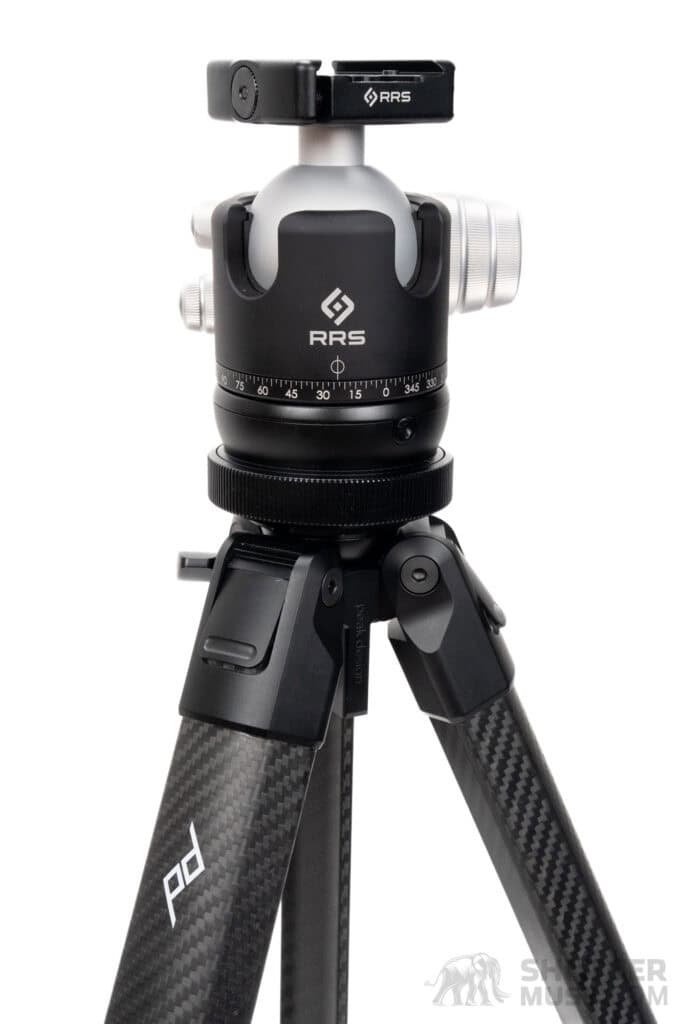
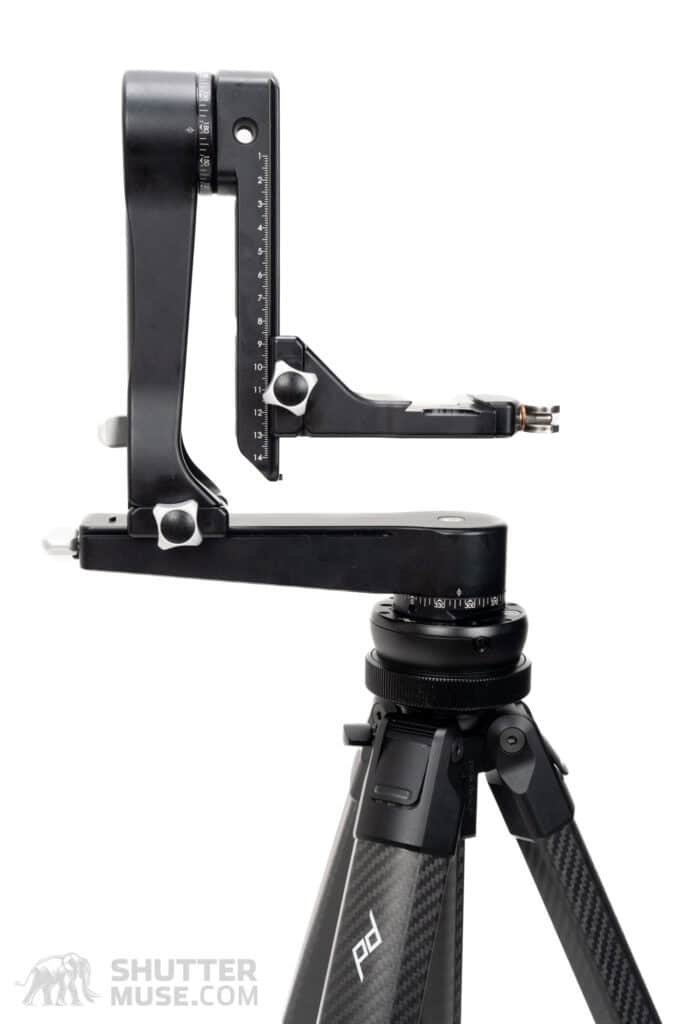
At around $120, the Pro Leveling Base is reasonably priced for this type of accessory and useful if you genuinely need the leveling tilt feature. However, if your main reason for buying it is to use an existing ball head with a Peak Design Pro Tripod, and you don’t need the leveling capability that a fluid or gimbal head needs, or you don’t need perfectly level panning for panoramic photography, then $120 suddenly seems very expensive. I’m a big fan of the FlexShooter tripod heads, but since they have built-in leveling, adding another leveling base is redundant in function, more expensive, and heavier than necessary.

It is disappointing that Peak Design has not created a Pro Tripod version of the Universal Head Adapter, which is optional for the Travel Tripod. This adapter offers a simple, lightweight, flat plate with a 3/8″-16 screw mount for a ball head. It’s an ideal solution for most people who want to use a ball head with the Travel Tripod and don’t need the function of a leveling base, and it costs just $25. A Pro Tripod-Compatible version of this platform, coming in at around $35-40, is a hole in an otherwise well-thought-out tripod system. How about it, Peak Design? Please make one in the future.
Spike Feet
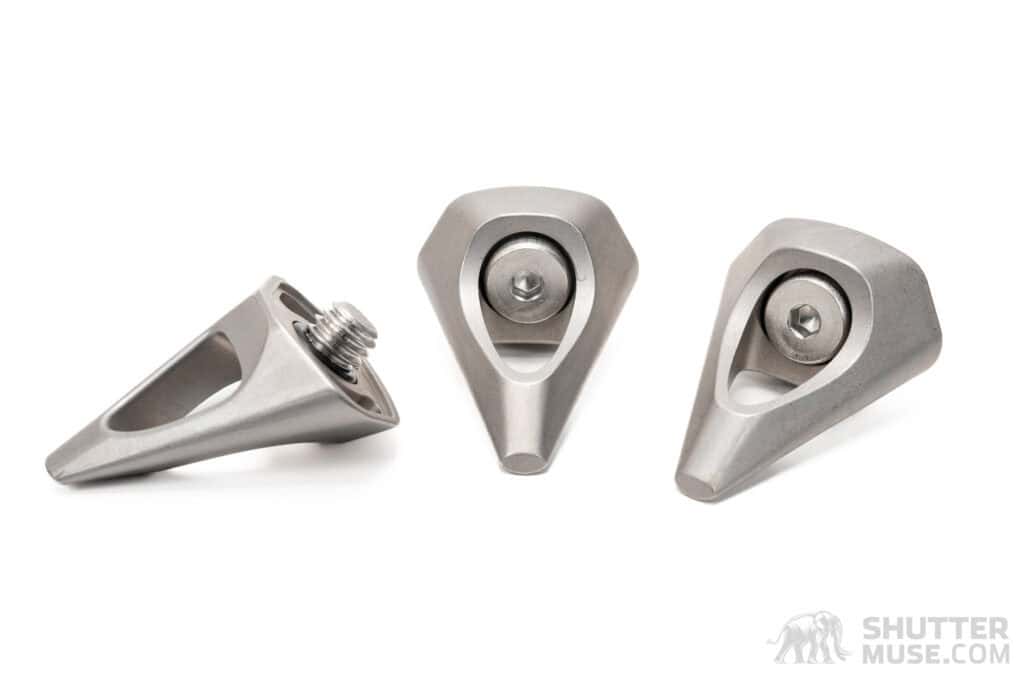
Peak Design offers two versions of the Pro Spike Feet: one designed for the Pro Lite tripod and another designed for the Pro and Pro Tall models, which accommodate their slightly larger leg tube diameter. The Spike Feet are made from durable 420 stainless steel, and both versions are priced at $49.95, which seems reasonable for tripod feet that are obviously well-machined.
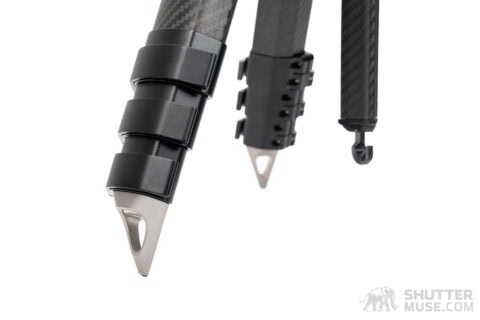
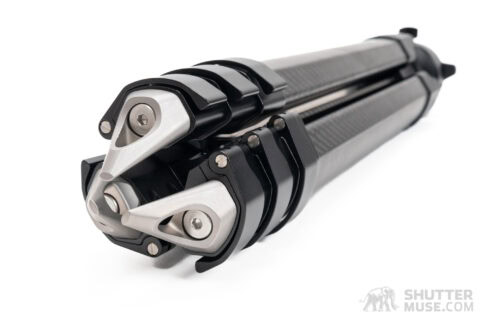
These Spike Feet are among the shortest and least spiky tripod feet available on the market. They perform well on soft, muddy, or boggy ground but offer little advantage on hard rock or ice, so they might not be an immediately necessary purchase. It depends on where you usually shoot. They install using the tripod’s included 4mm hex tool. It’s a shame there isn’t a dedicated pocket in the tripod’s case to carry them until you need them, or to hold the standard feet when the Spike Feet are installed.
Compared to the Peak Design Travel Tripod
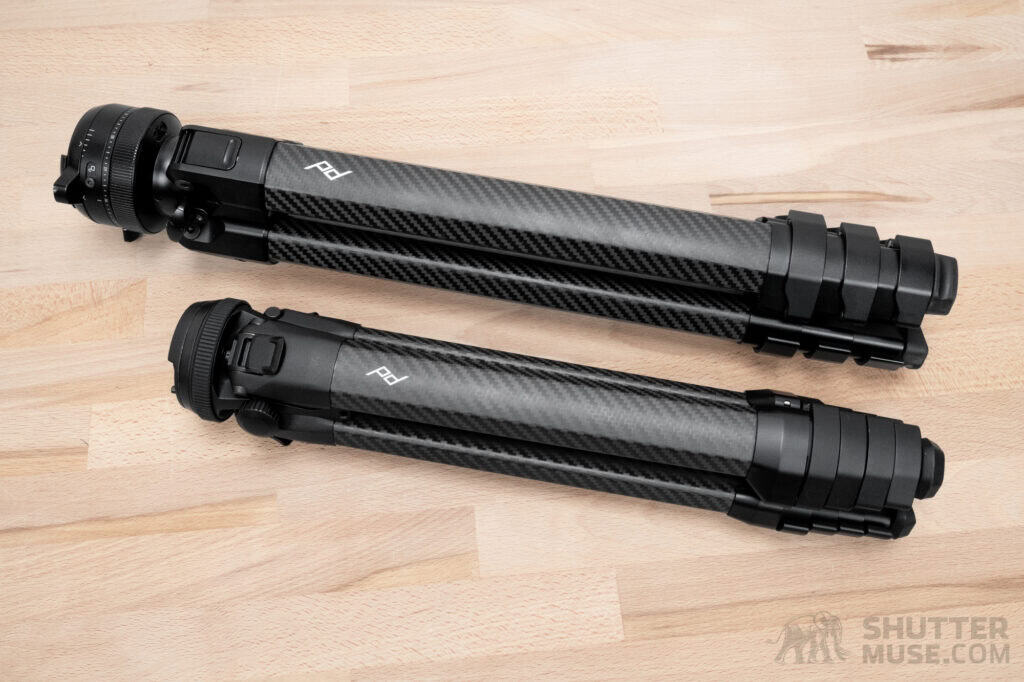
| Travel | Pro Lite | Pro | Pro Tall | |
|---|---|---|---|---|
| Collapsed Length | 15.5″ (39.4 cm) | 19.2″ (48.8 cm) | 19.7″ (50.1 cm) | 22.9″ (58.1 cm) |
| Collapsed Diameter | 3.25″ (8.3 cm) | 3.35″ (8.5 cm) | 3.66″ (9.3 cm) | 3.66″ (9.3 cm) |
| Max height (center column raised) | 60″ (152.4 cm) | 64″ (162.5 cm) | 66.3″ (168.4 cm) | 77″ (197.4 cm) |
| Max height (center column down) | 51.25″ (130.2 cm) | 52.5″ (133.2 cm) | 54.3″ (138 cm) | 63.8″ (17.3 cm) |
| Min height (low mode): 14 cm (5.5”) | 5.5″ (14 cm) | 6.2″ (15.8 cm) | 6.3″ (15.9 cm) | 6.9″ (17.3 cm) |
| Leg Profile Size | 36.1mm | 41.7mm | 47.4mm | 47.4mm |
| Weight Capacity | 20 lbs (9.1 kg) | 35 lb (15.9 kg) | 40.1 lb (18.1 kg) | 40.1 lb (18.1 kg) |
| Leg Sections | 5 | 4 | 4 | 4 |
| Tabletop Conversion Kit | Optional | No | No | No |
| Spiked Feet | Optional | Optional | Optional | Optional |
| Use your own ball head? | Yes, with Universal Head Adapater | Yes, with Pro Leveling Base | Yes, with Pro Leveling Base | Yes, with Pro Leveling Base |
| Removable Center Column? | Yes | Yes | Yes | Yes |
| Case Included? | Yes | Yes | Yes | Yes |
| Tripod Tool Included? | Yes | Yes | Yes | Yes |
| Phone Holder Included? | Yes | Yes | Yes | Yes |
| Arca Plate Included? | Yes | Yes | Yes | Yes |
| Fluid Panning Function? | No | Yes | Yes | Yes |
| MSRP | $399.95 (Alu) / $599.95 (Carbon) | $799.95 | $899.95 | $999.95 |
If you’re thinking about one of the Peak Design Pro Tripods, you might have also wondered if the Peak Design Travel Tripod would suit your needs. The Travel Tripod lineup includes two versions: Aluminum and Carbon (reviewed here). The more affordable aluminum version costs half as much as the cheapest Pro Lite tripod ($399 versus $799), while the Carbon Travel Tripod is $200 less than the Pro Lite. Comparing the Travel Tripods to the more robust Pro and Pro Tall models only increases that price difference. In short, there are differences between these tripod lines, and you pay for those differences.
In reality, the price and specification gap between the Travel Tripod models and the Pro or Pro Tall models is so large that comparing them is pointless. If you need the capacity, rigidity, or height of either the Pro or Pro Tall tripod, you should not be considering the Travel Tripod. End of story.
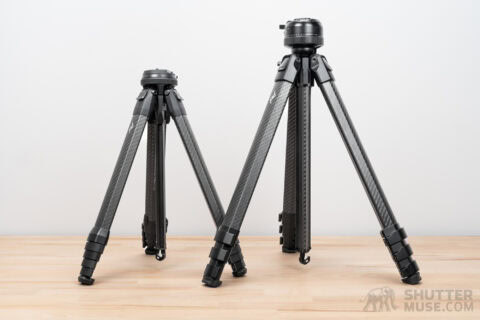
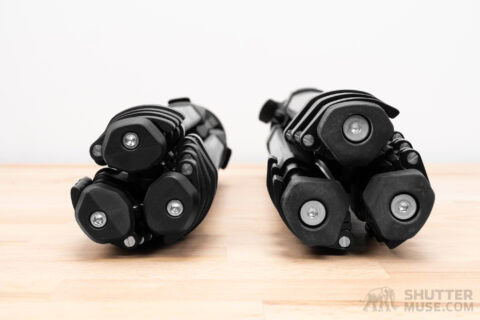
Too many people ignored my advice when the Travel Tripod first launched and tried to use it with too-heavy gear in unsuitable shooting scenarios. They got caught up in the industry hype and believed the Travel Tripod was some magical device that defies the laws of physics. It isn’t. It’s an excellent travel tripod. However, it still sacrifices stability for weight and collapsed dimensions. That’s just the reality of all travel tripods, and you shouldn’t buy one if stability is of greater concern to you than weight and compactness.
Of course, some people greatly value lighter weight and packability, and would rather have any kind of tripod with them than nothing at all. For those people, the question of whether to choose the Peak Design Travel Tripod or Pro Tripod is still a valid one, especially when narrowed down to the Pro Lite tripod. For that reason, I’ve pulled out the Pro Lite’s specifications and put them head-to-head with the Travel Tripod below.
| Collapsed Length | Collapsed Diameter | Max height (center column raised) | Max height (center column down) | Min height (low mode) | Weight Capacity | Weight | MSRP | |
|---|---|---|---|---|---|---|---|---|
| Travel | 15.5″ (39.4 cm) | 3.25″ (8.3 cm) | 60″ (152.4 cm) | 51.25″ (130.2 cm) | 5.5″ (14 cm) | 20 lbs (9.1 kg) | 56.9oz (1,613g)/ 46.1oz (1,307) | $399.95 / $599.95 |
| Pro Lite | 19.2″ (48.8 cm) | 3.35″ (8.5 cm) | 64″ (162.5 cm) | 52.5″ (133.2 cm) | 6.2″ (15.8 cm) | 35 lb (15.9 kg) | 60.1oz (1,705g) | $799.95 |
The Pro Lite tripod is much more stable than the Travel Tripod, and its versatility is greatly improved by the smooth fluid panning of the Pro Ball Head—something the Travel Tripod lacks. The Pro Lite also allows the addition of the Tilt Mod, making it an excellent and lightweight option for video shooting. In my experience, the Travel Tripod isn’t stable enough for video work at all. Overall, if you can afford it and don’t mind carrying a little extra weight, the Pro Lite is a better and more versatile tripod.
Is There Value at This Price?
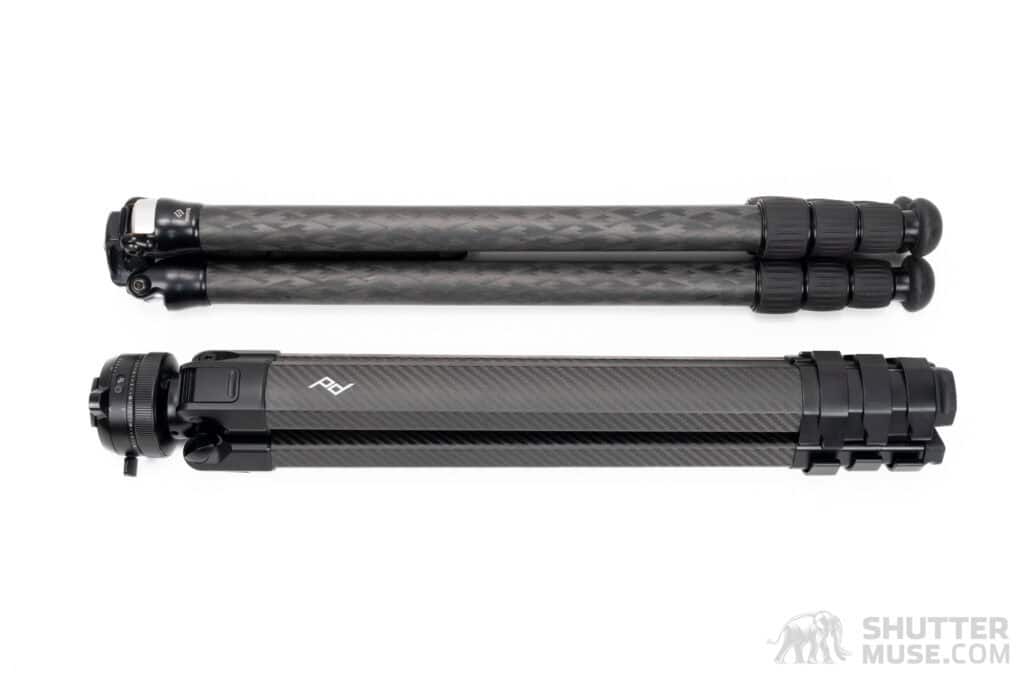
At first glance, the Pro Tripod’s price range of $799-$999 might cause sticker shock. However, it’s important to remember that, unlike most tripods in this price range, the Peak Design Pro tripods come with a ball head. So, what’s that worth in this context?
Well, it somewhat depends on whether you need that ball head. Although there aren’t exact apples-to-apples comparisons, a good quality inverted ball head with a very smoothly rotating panning base and an Arca clamp would cost around $150. I think that’s a fair value to assign to the Pro Ball Head in this pricing equation, giving the tripod legs a value of $649-$849. This price seems fair given their performance, build quality, and the clever compact nature of their design.
The confusion arises when you value having a new ball head less because you already own a good one. If you want to keep using that existing ball head, fluid head, or gimbal, you’ll need to purchase the Pro Leveling Base for an additional $120. Unfortunately, if you don’t intend to use it, you can’t sell the included Pro Ball Head since it’s incompatible with all other tripods. This significantly changes the value proposition and raises the effective cost of the tripod legs to $919-$1,119.
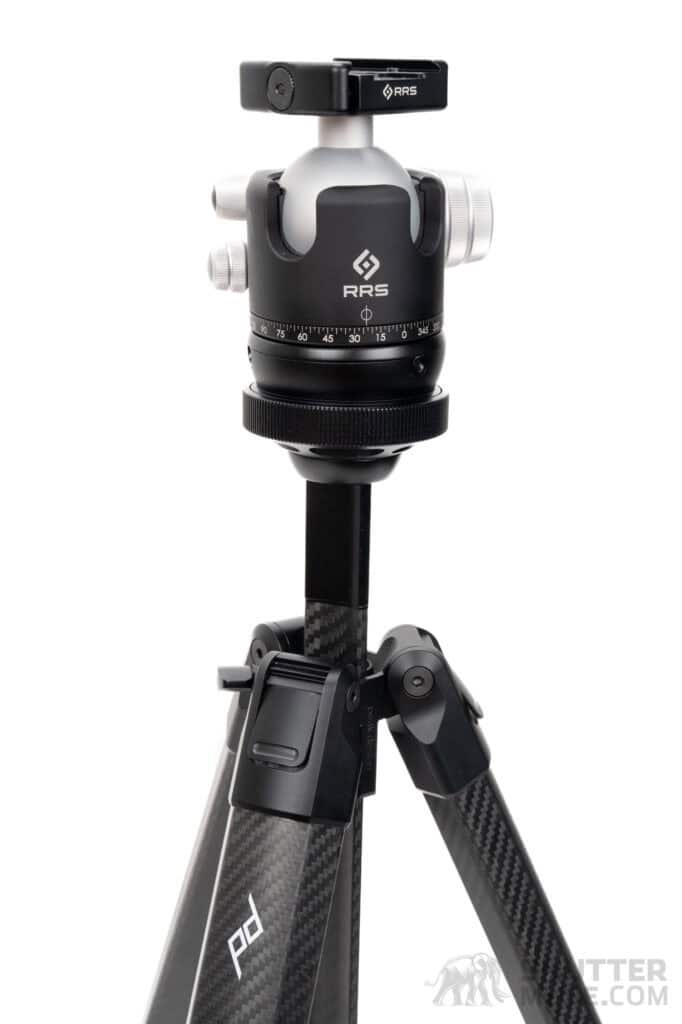
It’s fair to say that, when comparing these two price ranges, the Pro Tripod offers much better value for those who plan to use the included Pro Ball Head. Less so for people who will only use the head occasionally, and even less so if they never intend to use it at all. The difference in value between these scenarios is significant enough to influence some people’s purchasing decisions.
If you don’t need the included Pro Ball Head because you prefer to use a gimbal head or a regular ball head that you already own, it places these PD Pro Tripods in more direct competition, price wise, with the outstanding Series 2 and Series 3 Really Right Stuff tripods (40lb and 85lb capacity), Series 3 Gitzo tripods (61lb capacity), or ProMediaGear 3-Series tripods (60lb capacity). Those are some big names that carry a lot of clout, and, dare I say it, a lot more prestige than Peak Design.
When you start spending this kind of money on a tripod, photographers are, rightfully so, a little more particular about what they need and what works for them. It’s much more likely that photographers shopping in this price range already have a preferred tripod head they have invested a lot of money in. With this in mind, it’s unfortunate that Peak Design doesn’t offer the Pro Tripod range with a simple flat plate and a 3/8″-16 stud, without the Pro Ball Head. This would greatly reduce the entry price for those who already have a preferred tripod head, and it would make it more competitive with other well-regarded tripods and Made-in-USA brands.
Conclusion
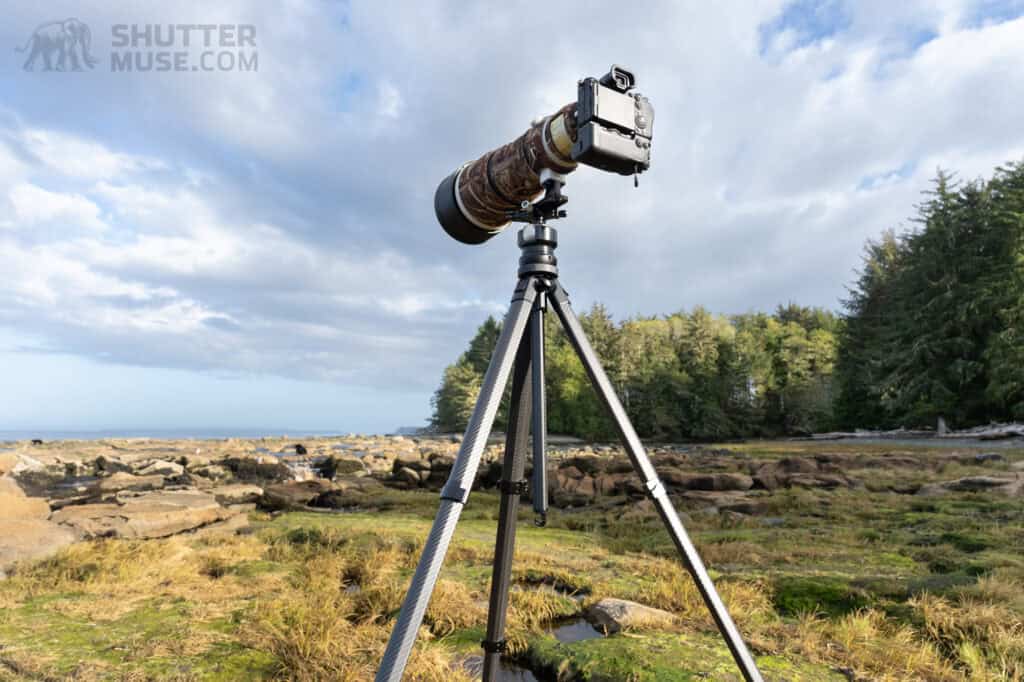
The Peak Design Pro Tripod range is an excellent addition to the brand’s catalog and the tripod market overall. All three models are a big step up from the wildly popular Travel Tripod in terms of stability, function, and build quality. Stability is hard to quantify without serious scientific testing. Still, my sense after testing all three models is that they are certainly comparable to my Really Right Stuff 2-Series tripod, with the Pro Tall coming extremely close to my RRS 3-Series when holding my 600mm f/4.
I appreciate that the tripod comes in three sizes, letting photographers prioritize what matters most. Those who prefer a lighter, shorter tripod at the cost of some stability can choose the Pro Lite model. Those needing a durable workhorse with maximum stability for their heaviest super telephoto lenses can opt for the Pro Tall model. Meanwhile, those looking for something in between might find the standard Pro model to be the best choice, which I suspect will be the most popular.
Perhaps the most surprising —and yet potentially polarizing — feature of all the Pro Tripod models is the included Pro Ball Head. The level of support it offers, along with the exceptionally smooth fluid panning base, makes it an absolute pleasure to use. Truly, I was not expecting to enjoy it as much as I did.
However, the cost of a head this well-built must be factored into the retail price, and it’s clear you are paying quite a lot for its inclusion. That’s great if you are in the market for a new ball head, but less so if you already own a great ball head, or if you want to fit the tripod with a different kind of head, such as a fluid head or a gimbal. Since Peak Design doesn’t offer the tripod without the head, you’re always paying for it, even if it ends up being a paperweight.
The fact is, this will change the value proposition for some. With the prices of the Pro Tripod models rising into Gitzo and RRS territory, it’s easy to justify the cost when you consider the savings from the included, excellent tripod head. If you don’t need that head, these tripods face some stiff competition, and their perceived value suffers. All that said, if your budget can stretch to any of these models, and they suit your needs, I can highly recommend them, and, in particular, I’d certainly be happy if the Pro Tall model was my own daily driver tripod.
Where to Buy
The Pro Tripod range is available through the links below. Peak Design offers free shipping on these higher-priced items, with warehouses worldwide to speed up delivery. I always recommend buying directly to best support your favorite brands, but I’ve also included some third-party links.
- PD Pro Lite Tripod – Peak Design / B&H / Adorama / WEX (UK)
- PD Pro Tripod – Peak Design / B&H / Adorama / WEX (UK)
- PD Pro Tall Tripod – Peak Design / B&H / Adorama / WEX (UK)
- PD Pro Leveling Base – Peak Design / B&H / Adorama / WEX (UK)
- PD Tilt Mod – Peak Design / B&H / Adorama / WEX (UK)
- PD Pro Tripod Spikes – Peak Design / B&H / Adorama / WEX (UK)
- PD Pro Lite Tripod Spikes – Peak Design / B&H / Adorama / WEX (UK)

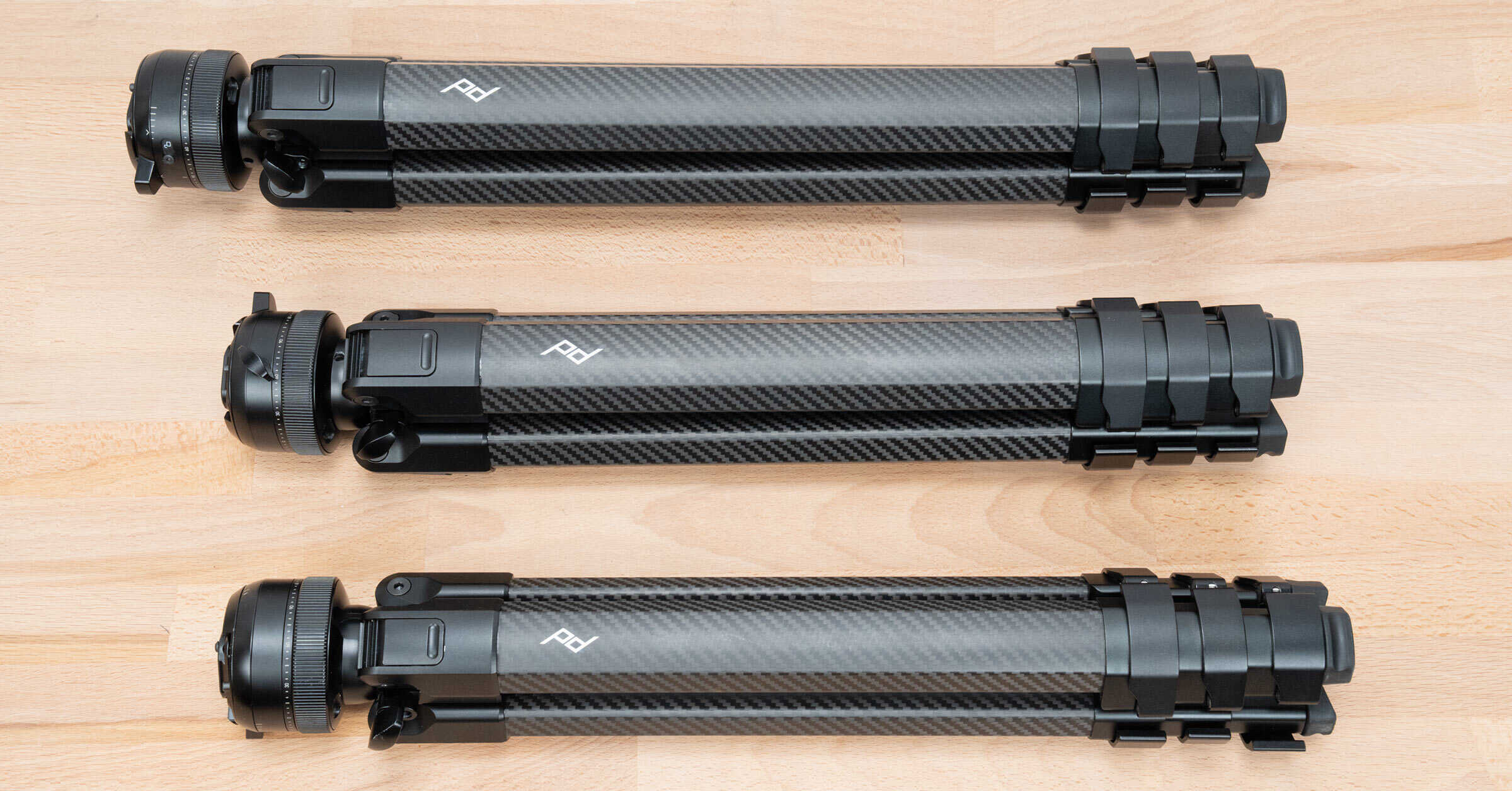
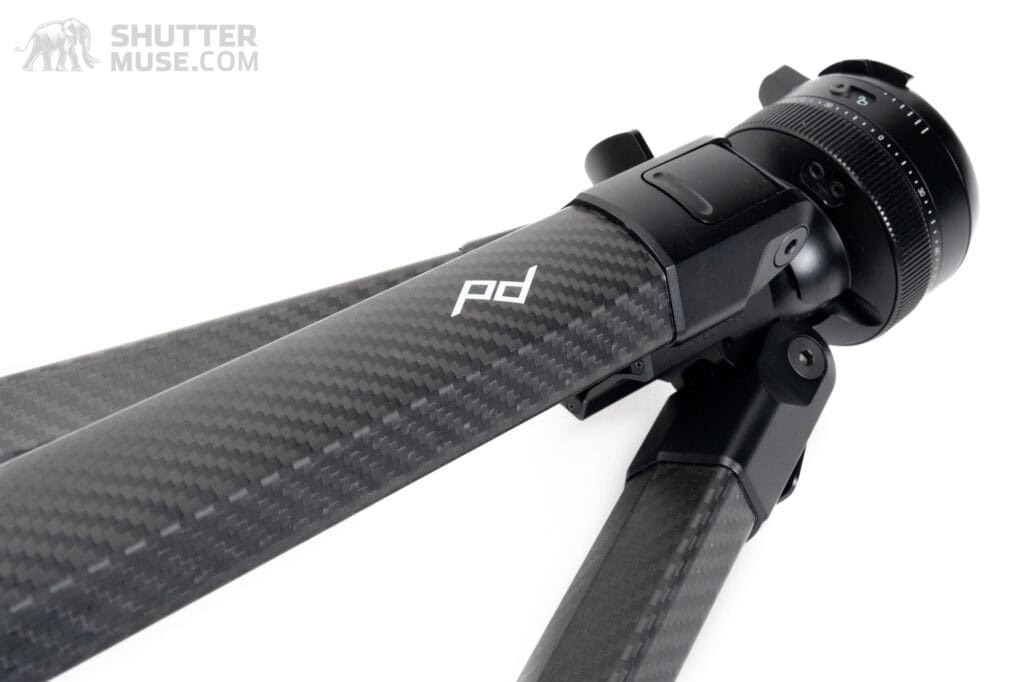
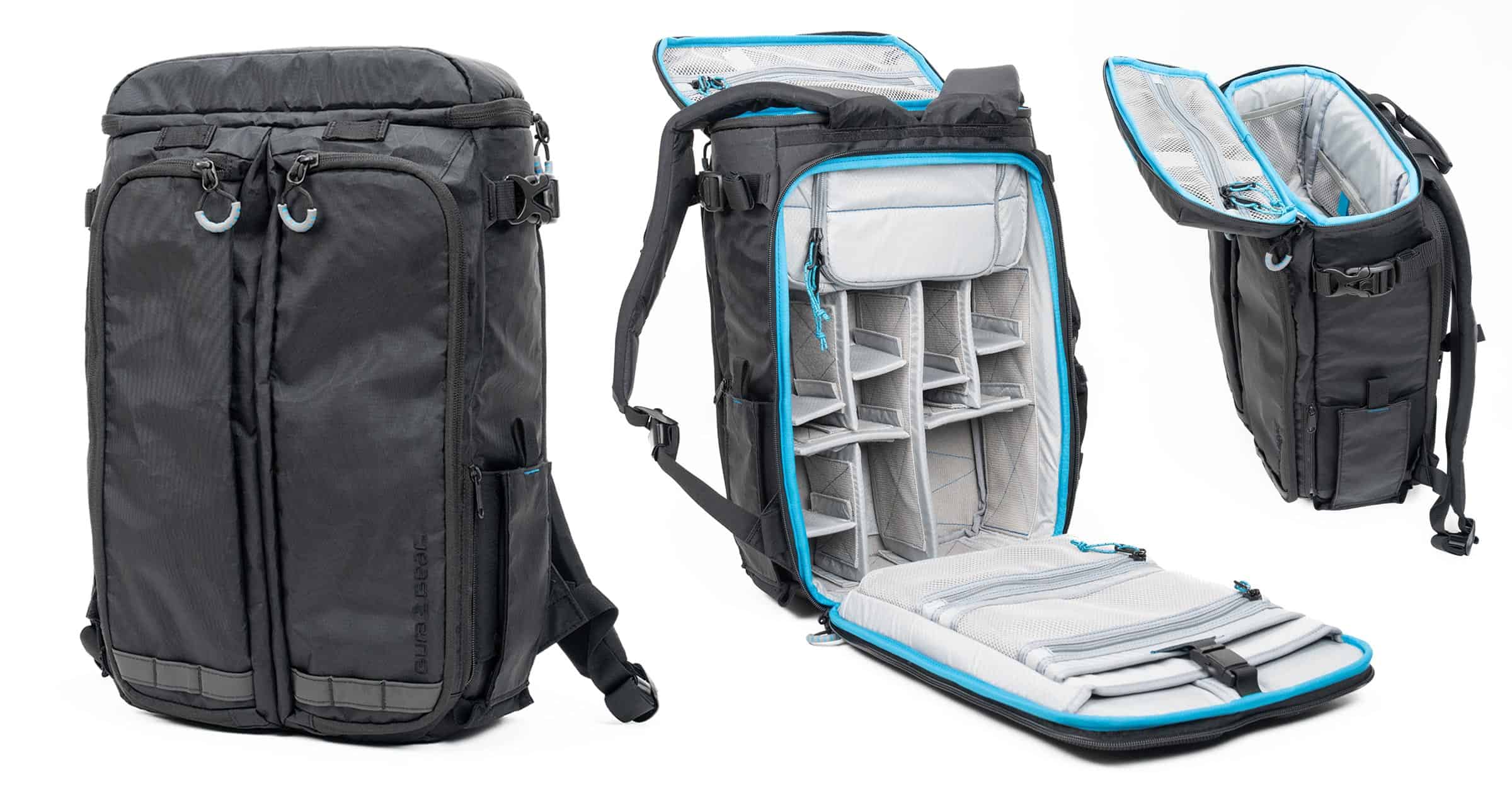
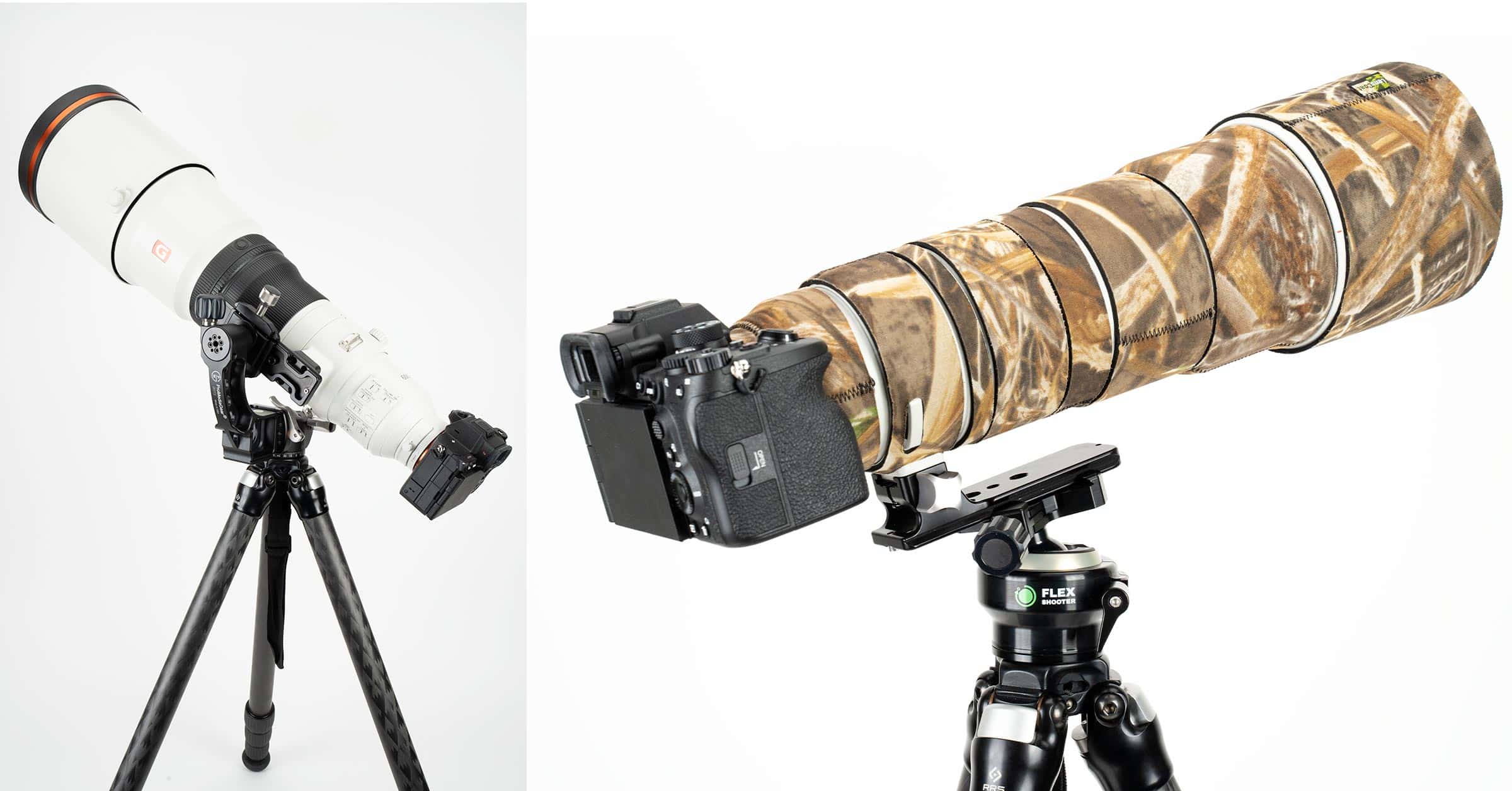
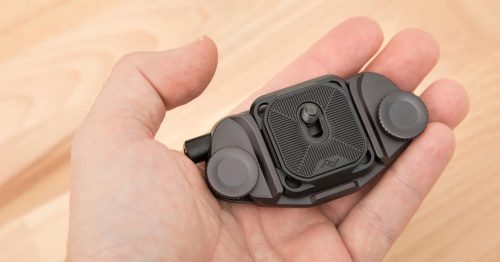
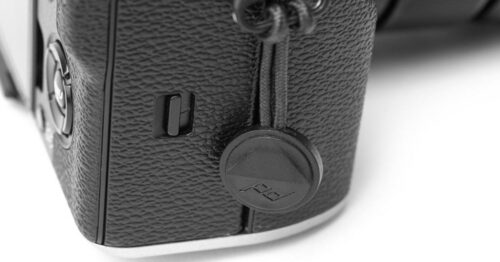

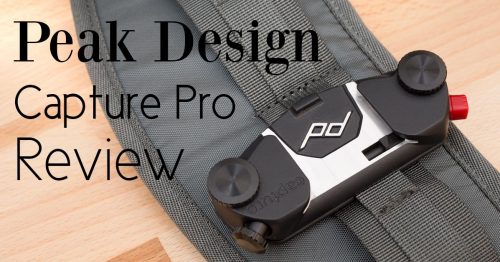


First of all, thanks for this review, Dan. Really well made and perfectly balanced between well deserved praise and constructive criticism.
Here are my 50 cents. I owned the original travel tripod, which I sold for stability reasons. Meanwhile I made a big mistake by backing Benro’s KS campaign for the Theta Max. I was not really interested in the self leveling mechanism but I was intrigued by the compactness but still retaining the round cross section of the legs paired with the carbon fibre arrangement that you usually find with the big brands but at a lower price point than these brands. Benro dropped that fibre pattern on the standard version (for cost reasons, I guess), but kept it on the Max version. I still did not get my Theta Max, and honestly with all the quality issues they have I‘d rather have my pledge refunded than taking delivery (should that ever happen at all). That’s a different story though.
What I really want to point out is that there is a very good reason for having the Fibre pattern as it is on the legs of the big brands. If you want to transfer torque only, you would place your fibres in a +/- 45° pattern, and, voilà, that’s exactly what you will find on transmission shafts of race cars. If your dominant load case acting on the tubes is bending, you want to have all your fibres oriented along the tube axis, because, bear in mind, the composite‘s stiffness is 3 orders of magnitude lower perpendicular to the fibre direction than along the fibre direction (materials scientists call this an anisotropic material).
Obviously, the legs on a tripod predominantly see bending load. But a tube made of only 0° degree fibres would not keep its round shape due to the non-existent stability in any direction other than the one along the tube axis. Additionally, there are constraints from the manufacturing method, which is usually filament winding for expensive tripod legs. The sweet spot to provide best bending stiffness and tube‘s self integrity and manufacturability is a fibre pattern of +/- 10°. The big brands vary that angle from layer to layer between +/- 5-25° to have a perfectly balanced layup. And this is exactly what you see on e.g. RRS. Now, filament winding is a more expensive process than woven fabric layup. However, with woven fabrics you always end up with only half the fibres taking any load and providing stiffness. You see, the likes of RRS really did their homework when designing there carbon fibre layups. Obviously, this is easier done on circular tubes than trapezoid ones as on the PD tripod, but filament winding is not solely applicable to circular tubes. It could have been applied to the trapezoidal shape as well. And this is exactly what I expect from a tripod in that price class.
Having read your review, Dan, I must admit that I briefly felt tempted to give in to some of the other features. I certainly love the idea of the tilt video head accessory.
Cheers,
Urs